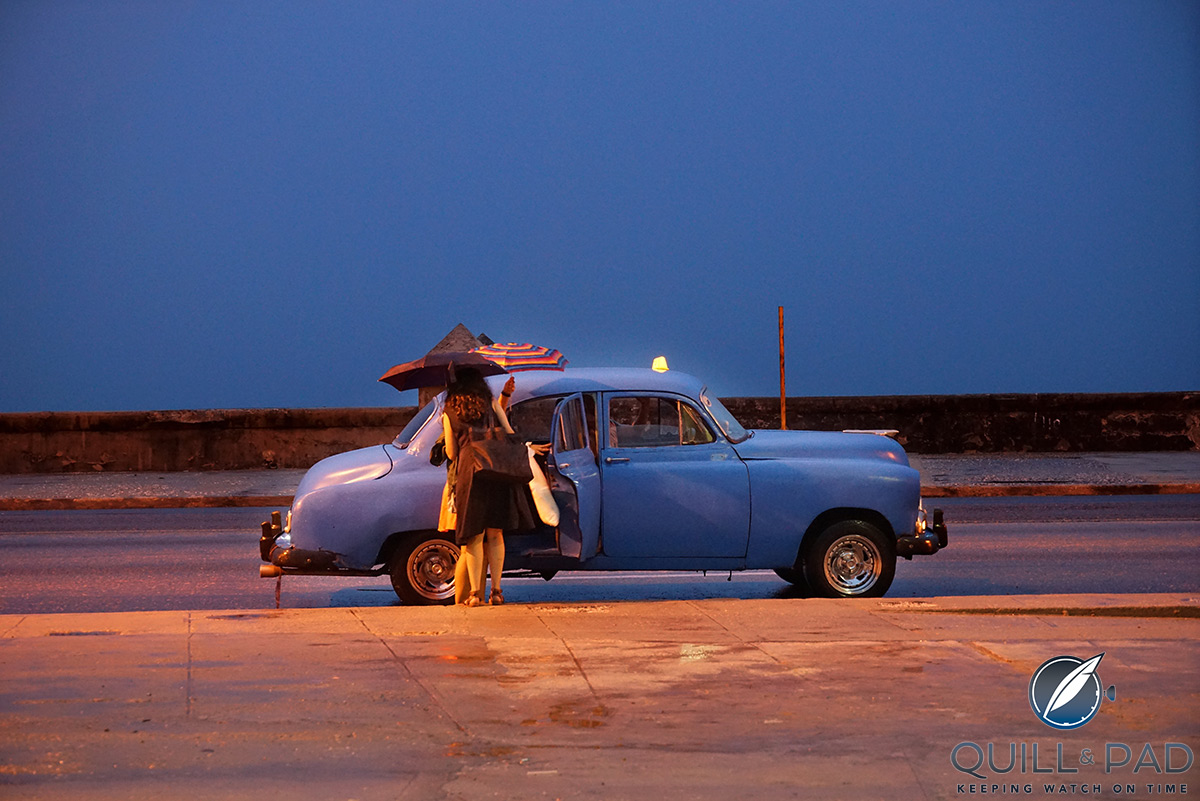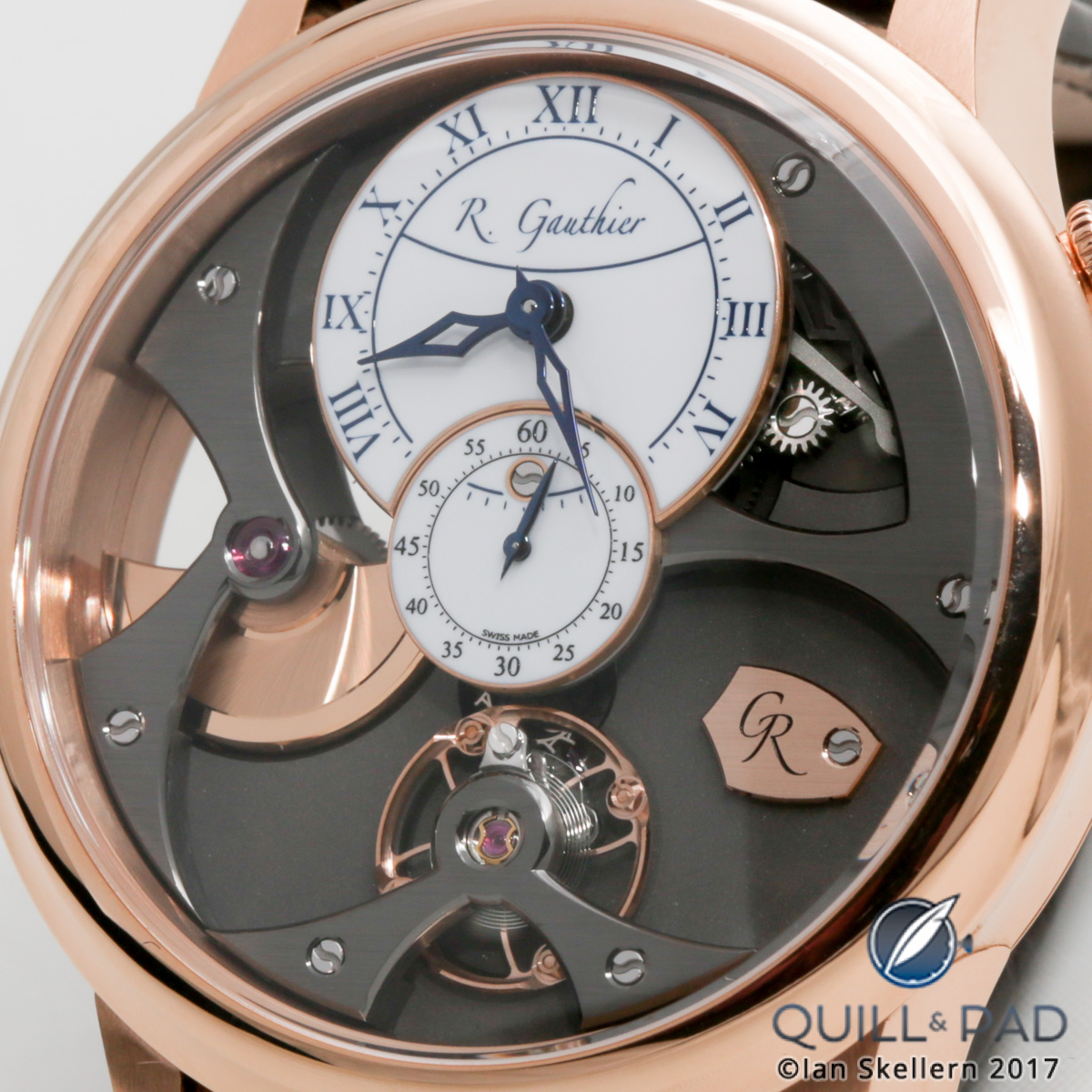The 2016 Heuer Monza 40th Anniversary edition is one of the most anticipated TAG Heuer releases for some time, and for those of you waiting to see and read more about the latest from TAG Heuer’s re-edition range, you’re in luck, because we’ve gone hands-on with the Monza for one of the first detailed reviews. The 2016 model is an perfect blend of the past- two parts 1976 Monza and two parts 2000 Monza- two watches that actually had very little in common other than a name.
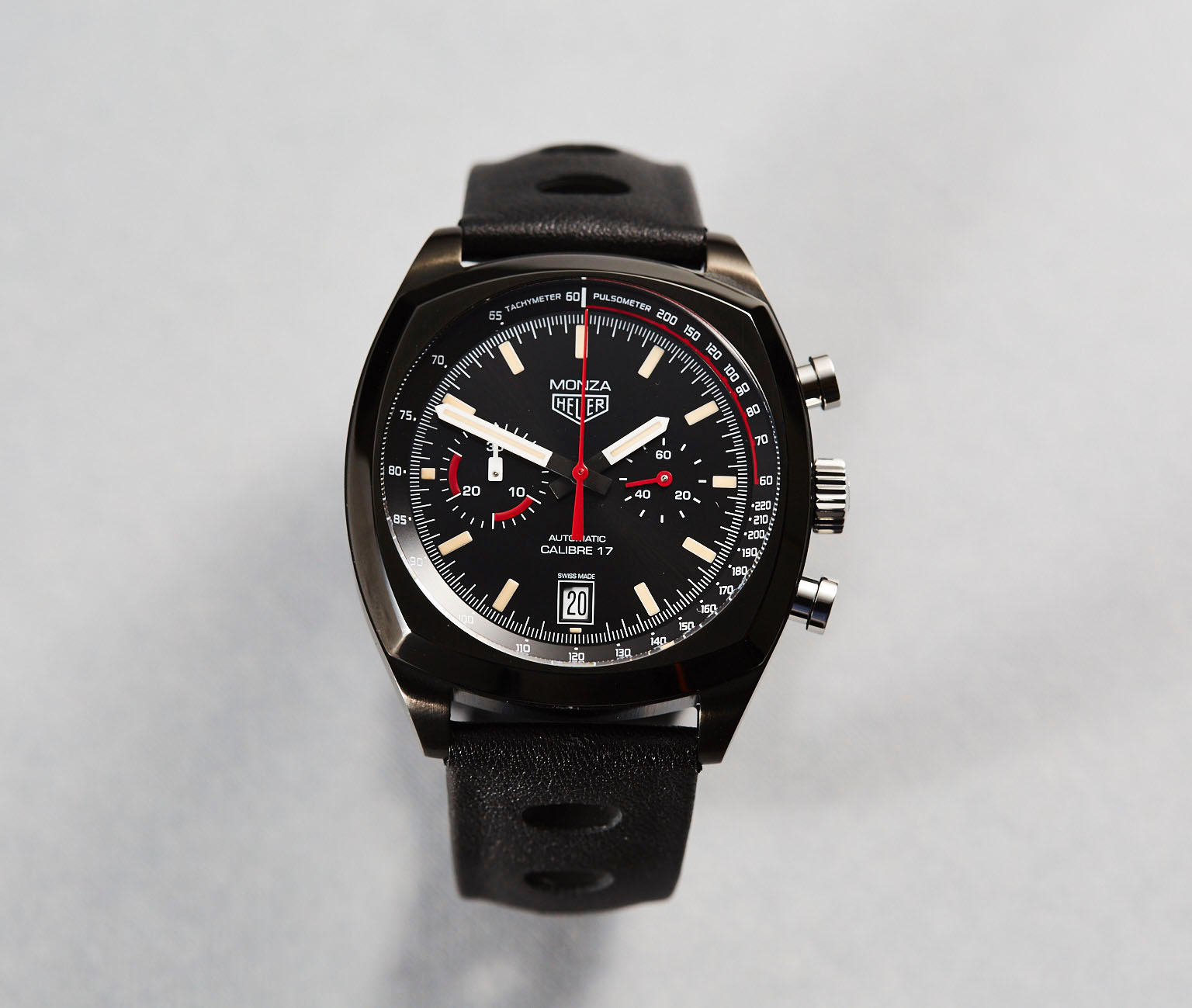 To cut to the chase, the 2016 model borrows the dial and hands of the 1976 model and adds those to an enlarged version of the 2000 Monza case. In many ways the combination shouldn’t work, because those are two very different watches, but it does. The 1976 Monza was effectively a sporty, special edition Carrera, and one of the first watches to offer a blackened PVD case. The 2000 version was an update of a 1930’s Heuer mono-pusher chronograph with a look that veered towards the formal rather than the sporty. Yet here we are with a design in perfect harmony and looking every bit a worthy successor to the Monza name.
To cut to the chase, the 2016 model borrows the dial and hands of the 1976 model and adds those to an enlarged version of the 2000 Monza case. In many ways the combination shouldn’t work, because those are two very different watches, but it does. The 1976 Monza was effectively a sporty, special edition Carrera, and one of the first watches to offer a blackened PVD case. The 2000 version was an update of a 1930’s Heuer mono-pusher chronograph with a look that veered towards the formal rather than the sporty. Yet here we are with a design in perfect harmony and looking every bit a worthy successor to the Monza name.
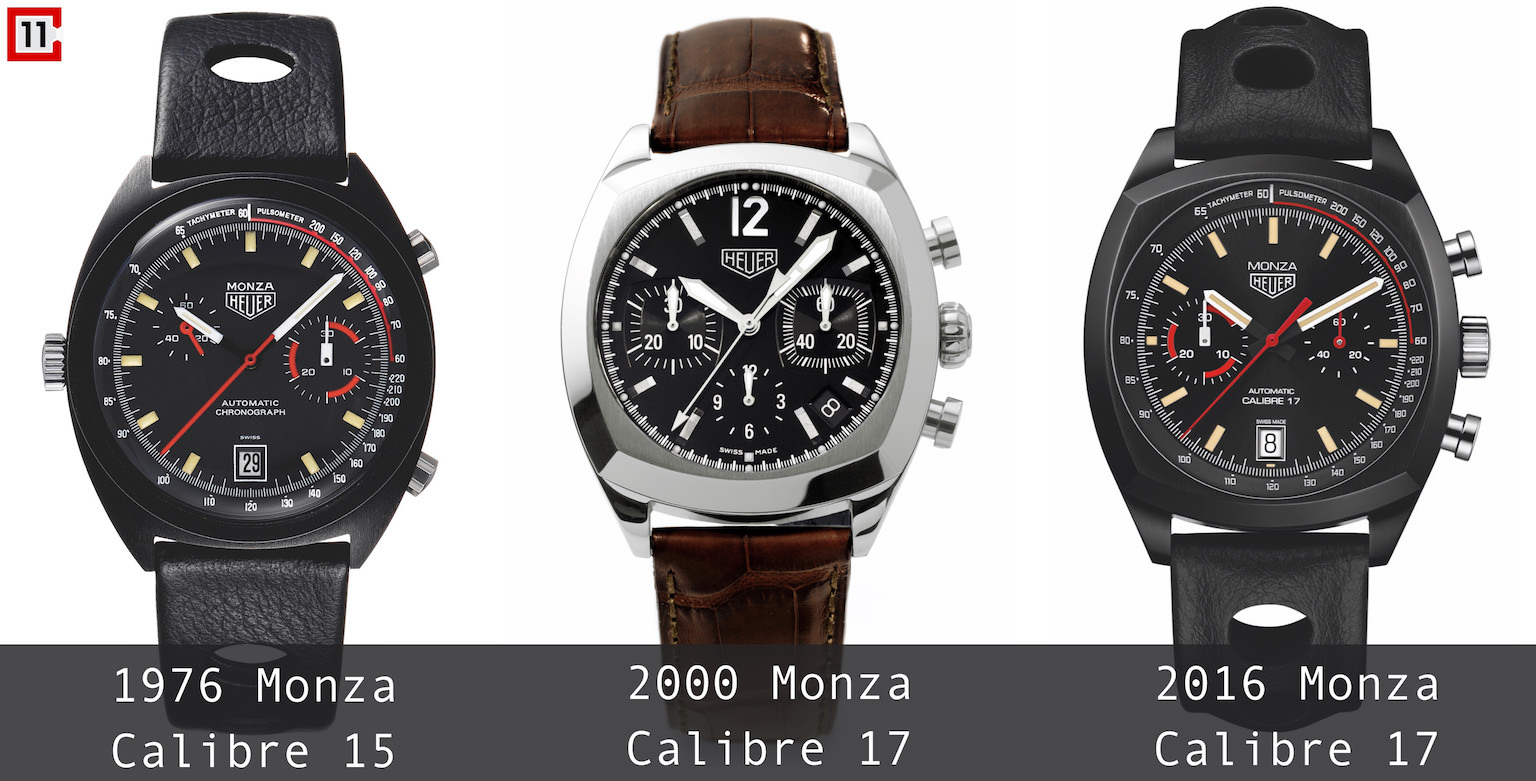
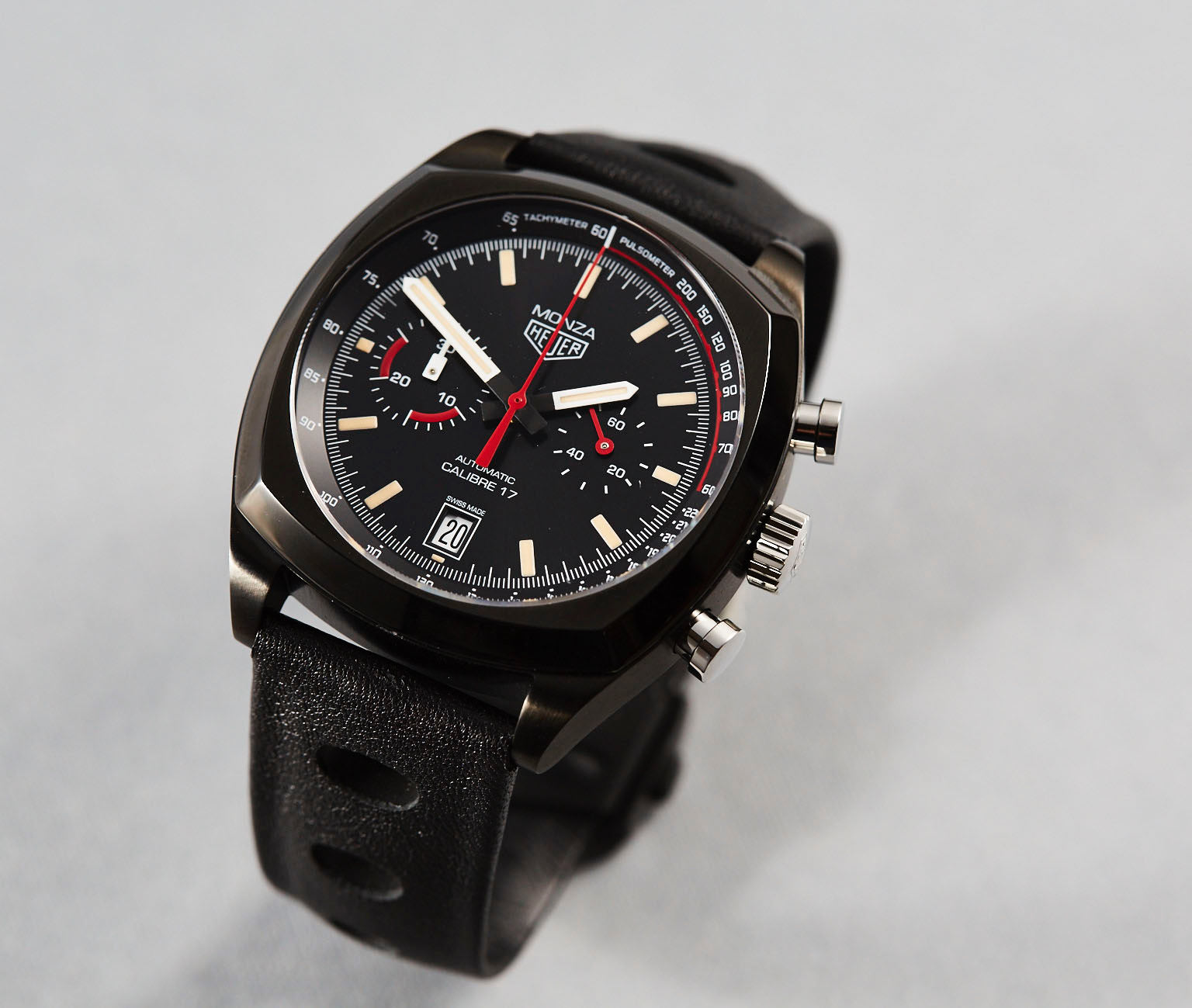 Having displayed the watch back in March at the Baselworld show, the good news for those waiting is that the Monza will go on sale in the next few weeks, and we were lucky enough to get our hands on the Monza for this in-depth review ahead of launch. And good news, we had a camera with us to bring you the most detailed photos yet of the new Chronograph.
Having displayed the watch back in March at the Baselworld show, the good news for those waiting is that the Monza will go on sale in the next few weeks, and we were lucky enough to get our hands on the Monza for this in-depth review ahead of launch. And good news, we had a camera with us to bring you the most detailed photos yet of the new Chronograph.
Dial
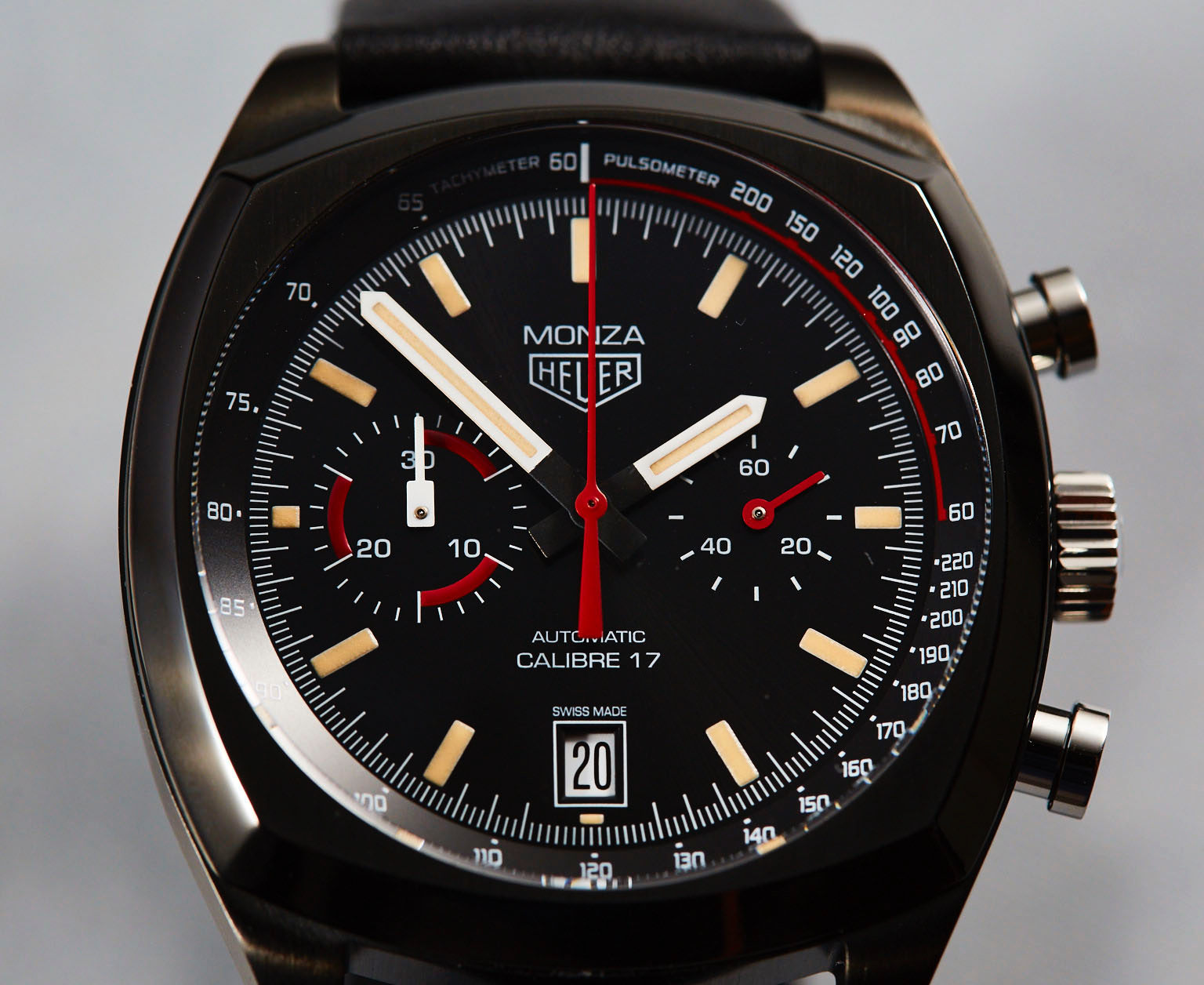 It’s like being transported back to the 1970s- there’s plenty going on with this dial. Starting with the scales on the watch, we have both the usual tachymeter scale- useful for measuring speed- and a Pulsometer scale. The Pulsometer scale was described by Mark Moss in an article he wrote for us a few years ago:
It’s like being transported back to the 1970s- there’s plenty going on with this dial. Starting with the scales on the watch, we have both the usual tachymeter scale- useful for measuring speed- and a Pulsometer scale. The Pulsometer scale was described by Mark Moss in an article he wrote for us a few years ago:
The third scale I referred to above is this, the pulsometer. One that Heuer is justifiably proud of, having held the patent for measuring the pulse rate on a watch or stopwatch since 1908.
There are some Heuers from that very early period with pulsometer scales but it, like the decimal scale, is quite limited in use so the watches are much rarer than tachys.
The scale works by counting out a specific number of pulses, usually 15, and then referring to the marked number on the scale to derive the pulse rate. The scales are usually marked with the number of pulses to count, as shown on the Carrera below by “Base 15”. The first watch with a scale I remember owning was a pulsometer – a non-chronograph Swatch, it nonetheless worked in the same way, by counting off 15 pulses when the second hand hit 60 and reading the result from the scale.
The average pulse rate for an adult is 60-100 so watches with combined scales often only show the pulsometer scale for 15 seconds, not expecting to need to measure pulse rates below 60. Michael Schumacher at his peak famously had a resting heart rate in the mid 30s, but during races an F1 driver’s pulse rate rises to over 150. The Carrera 2447 P was intended for medical professionals so can record pulse rates lower than 60 – in fact, although the lowest number it shows on the scale is 20, it could even be used to measure someone with no pulse at all!
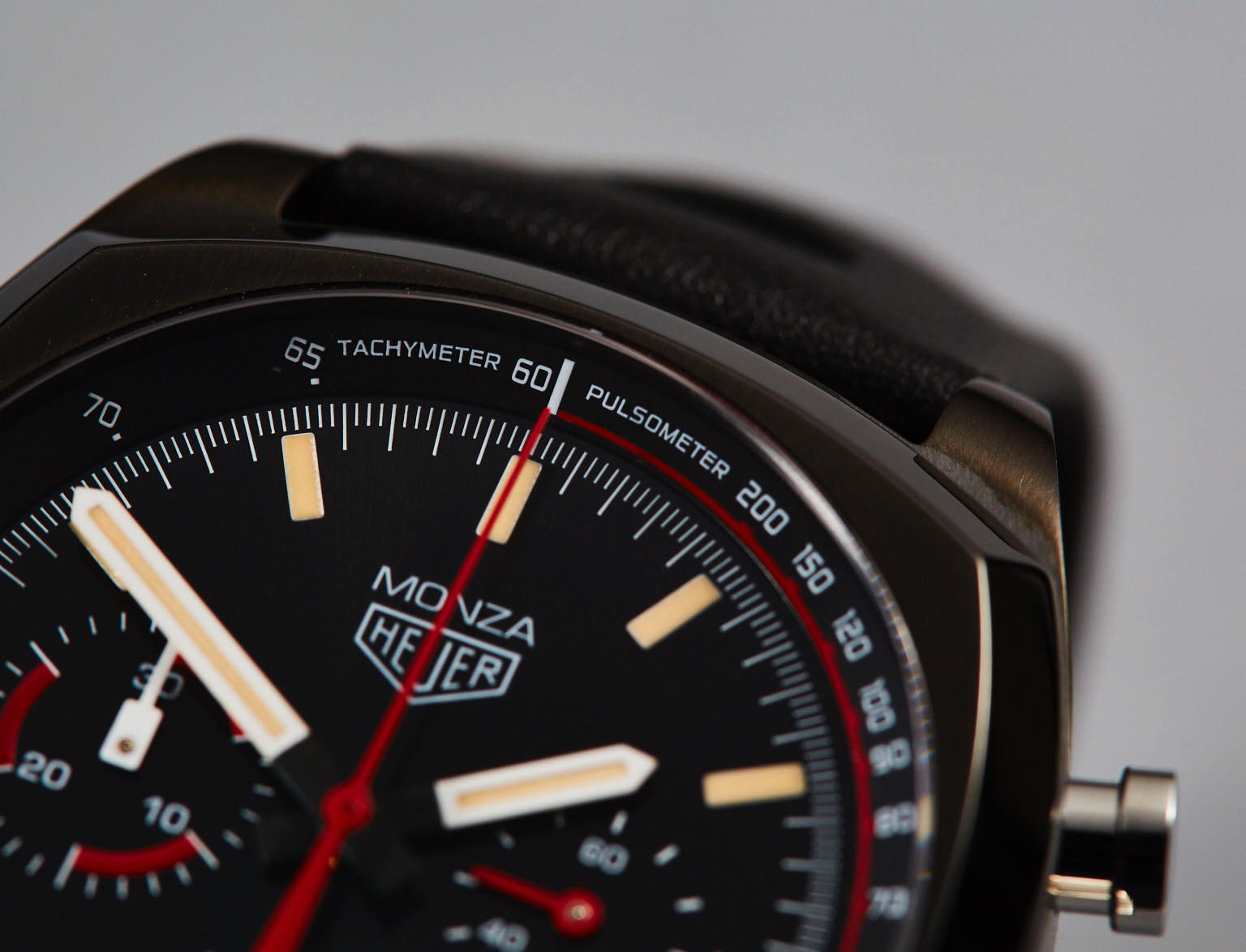 One of the recent trends for watch brands reissuing vintage-style watches is the use of yellowed-lume. It’s meant to replicate the yellowing of white lume that happens over time, turing the original white markers yellow. We’re not really fans of this “faux-vintage” look, and would rather wait for the colouring to naturally happen! Still, TAG Heuer has opted for a more subtle cream colouring than other brands have used, meaning that while you’ll notice it in close-up macro shots like these, on the wrist it’s less obvious.
One of the recent trends for watch brands reissuing vintage-style watches is the use of yellowed-lume. It’s meant to replicate the yellowing of white lume that happens over time, turing the original white markers yellow. We’re not really fans of this “faux-vintage” look, and would rather wait for the colouring to naturally happen! Still, TAG Heuer has opted for a more subtle cream colouring than other brands have used, meaning that while you’ll notice it in close-up macro shots like these, on the wrist it’s less obvious.
The hour markers are a perfect replica of the original “lume strips” on the original Monza and are matched perfectly to the design of the hands.
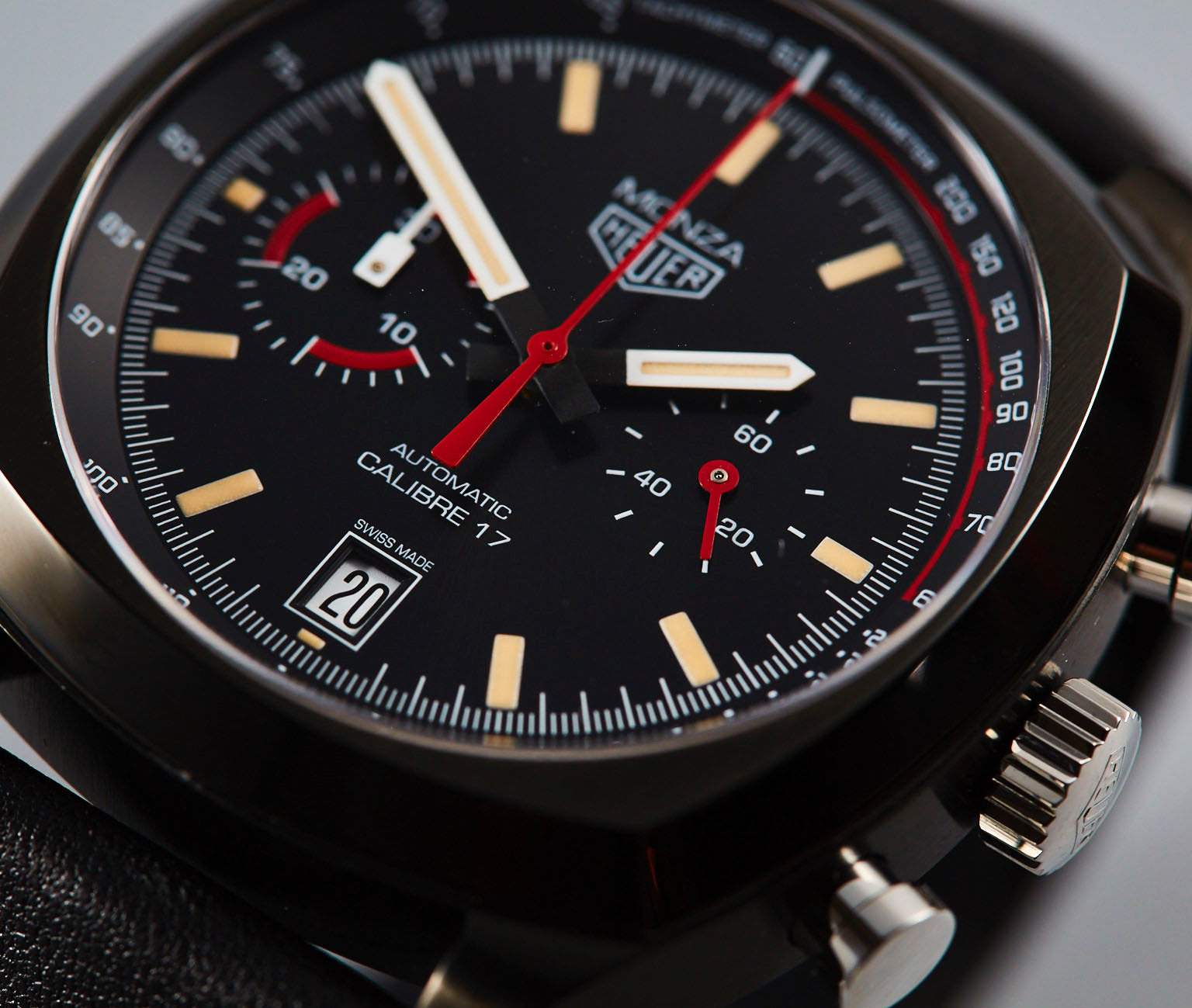 Keeping it authentic, TAG Heuer has also stuck with the original design of offering different hand-designs on the two sub-dials- a standard fire-red hand for the elapsed seconds (time) and 3 o’clock and a square-bottomed white hand at 9 o’clock for the 30-minute chronograph register- the same design used on the famous Chronomatic-powered watches of the 1970s.
Keeping it authentic, TAG Heuer has also stuck with the original design of offering different hand-designs on the two sub-dials- a standard fire-red hand for the elapsed seconds (time) and 3 o’clock and a square-bottomed white hand at 9 o’clock for the 30-minute chronograph register- the same design used on the famous Chronomatic-powered watches of the 1970s.
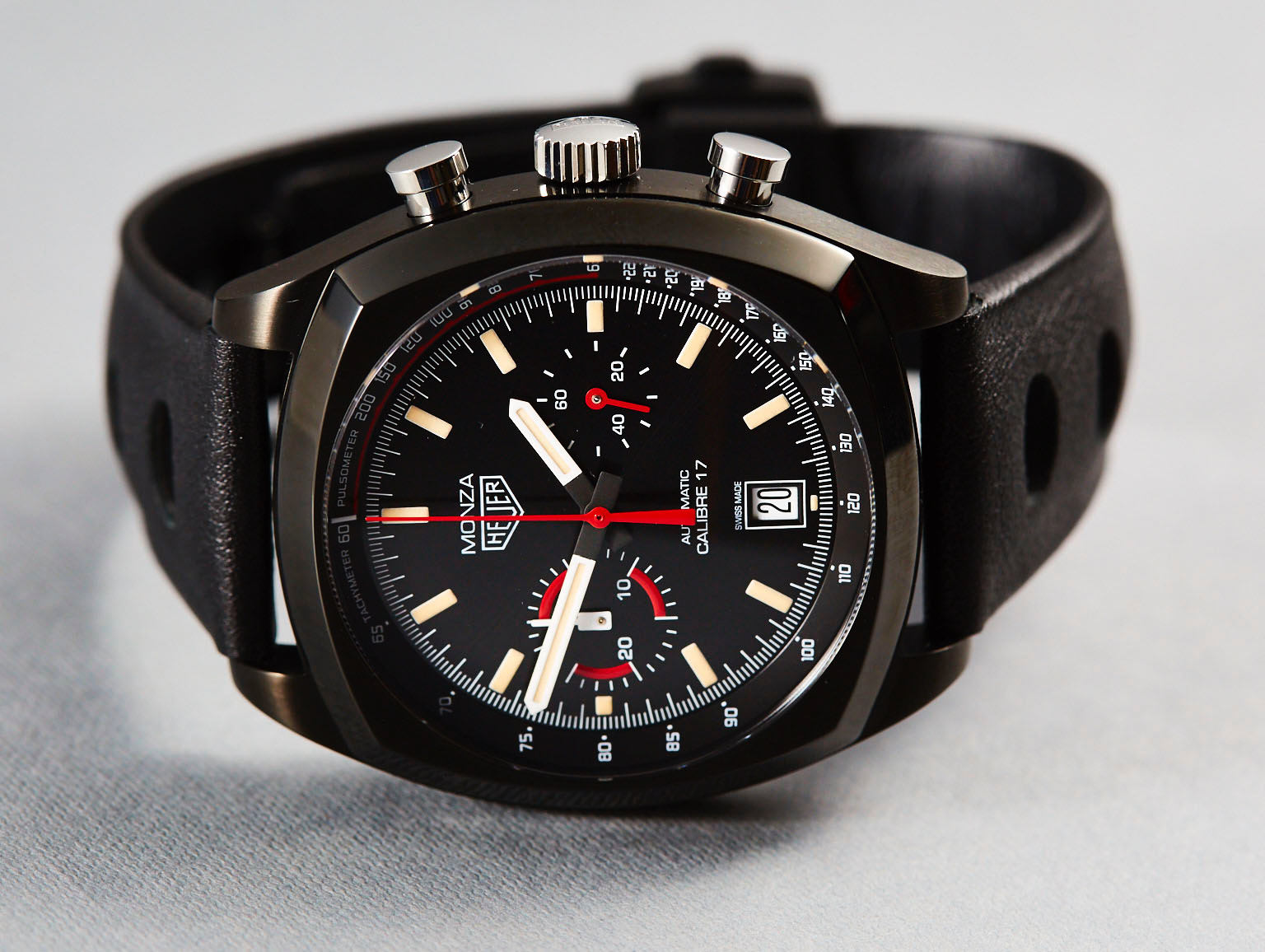 Despite this combination of multiple scales and differing hand designs and colours, the overall look of the dial is perfect. Sporty, yet still easy to read, with the only real change from the original being the “Calibre 17” text above the date window. The dial may look to be a flat-black in some of these photos, but actually has a wonderful starburst finish, which looks great.
Despite this combination of multiple scales and differing hand designs and colours, the overall look of the dial is perfect. Sporty, yet still easy to read, with the only real change from the original being the “Calibre 17” text above the date window. The dial may look to be a flat-black in some of these photos, but actually has a wonderful starburst finish, which looks great.
Case and Design
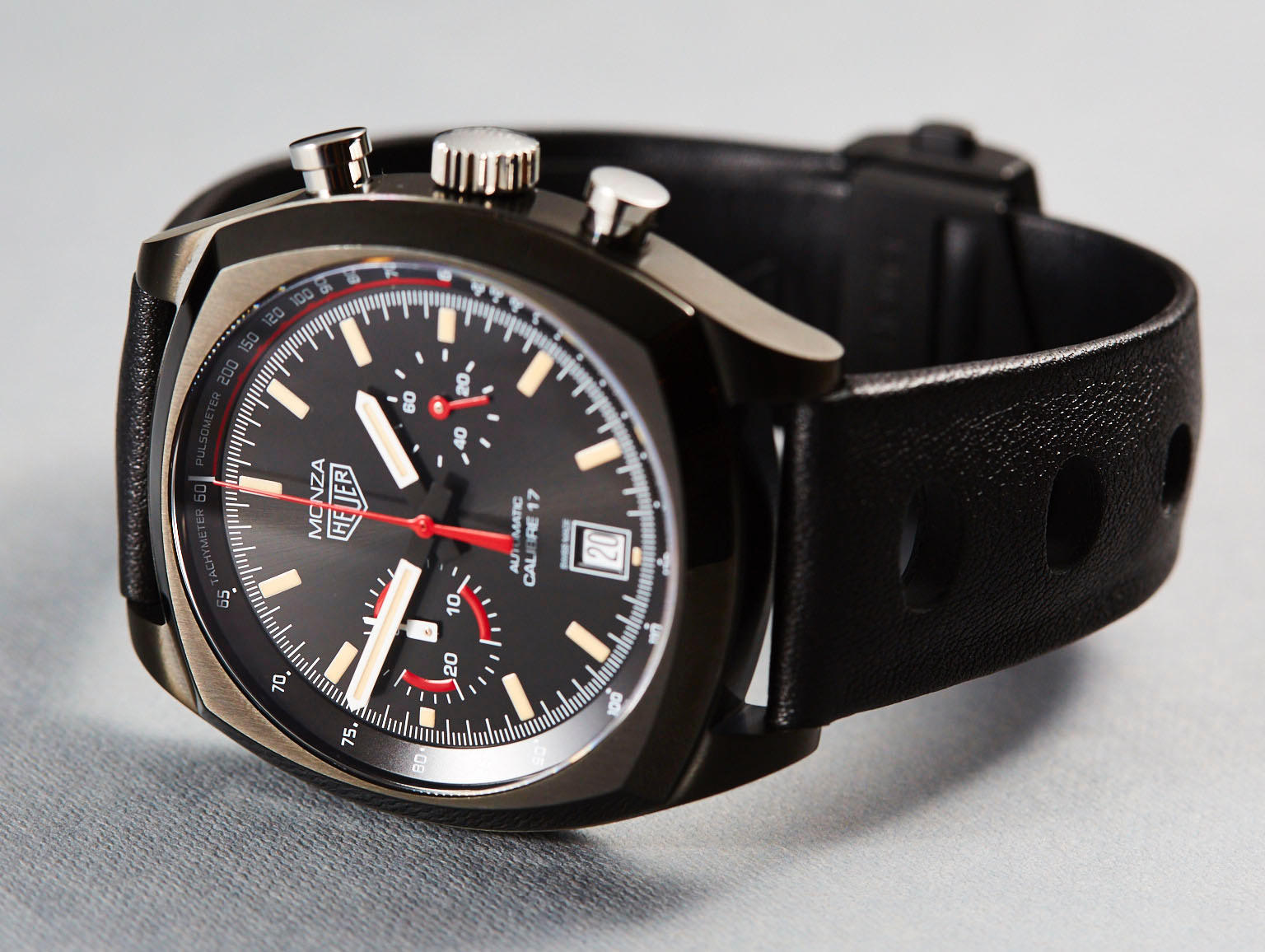 The Monza offers the same square-yet-round cushion case design of the 2000 Monza, a favourite of TAG Heuer collectors. The 42mm case is made from Grade 5 titanium and features alternate brushed (sides of the case) and polished (top of the case) finishes.
The Monza offers the same square-yet-round cushion case design of the 2000 Monza, a favourite of TAG Heuer collectors. The 42mm case is made from Grade 5 titanium and features alternate brushed (sides of the case) and polished (top of the case) finishes.
To achieve the blackened look, the Monza has a titanium-carbide coating, a world away from the PVD-applied coating offered on the 1970s Monza, which more often than not was applied to a brass case. Many people don’t know that the resistance of the black coating to scratches and general wear is more down to the hardness of the case than the hardness of the coating- which is why the soft Brass case of the 1970s often have worn poorly.
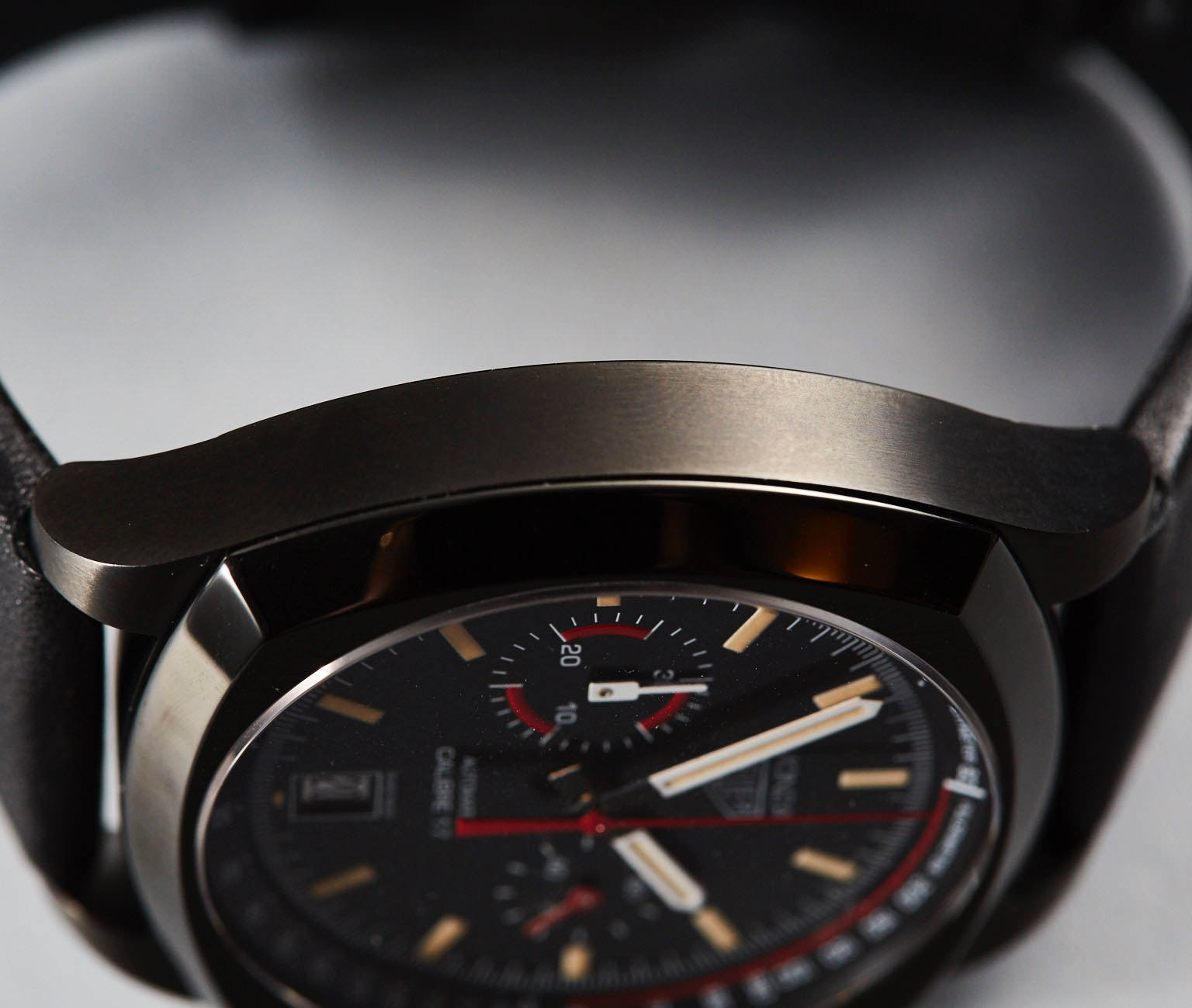
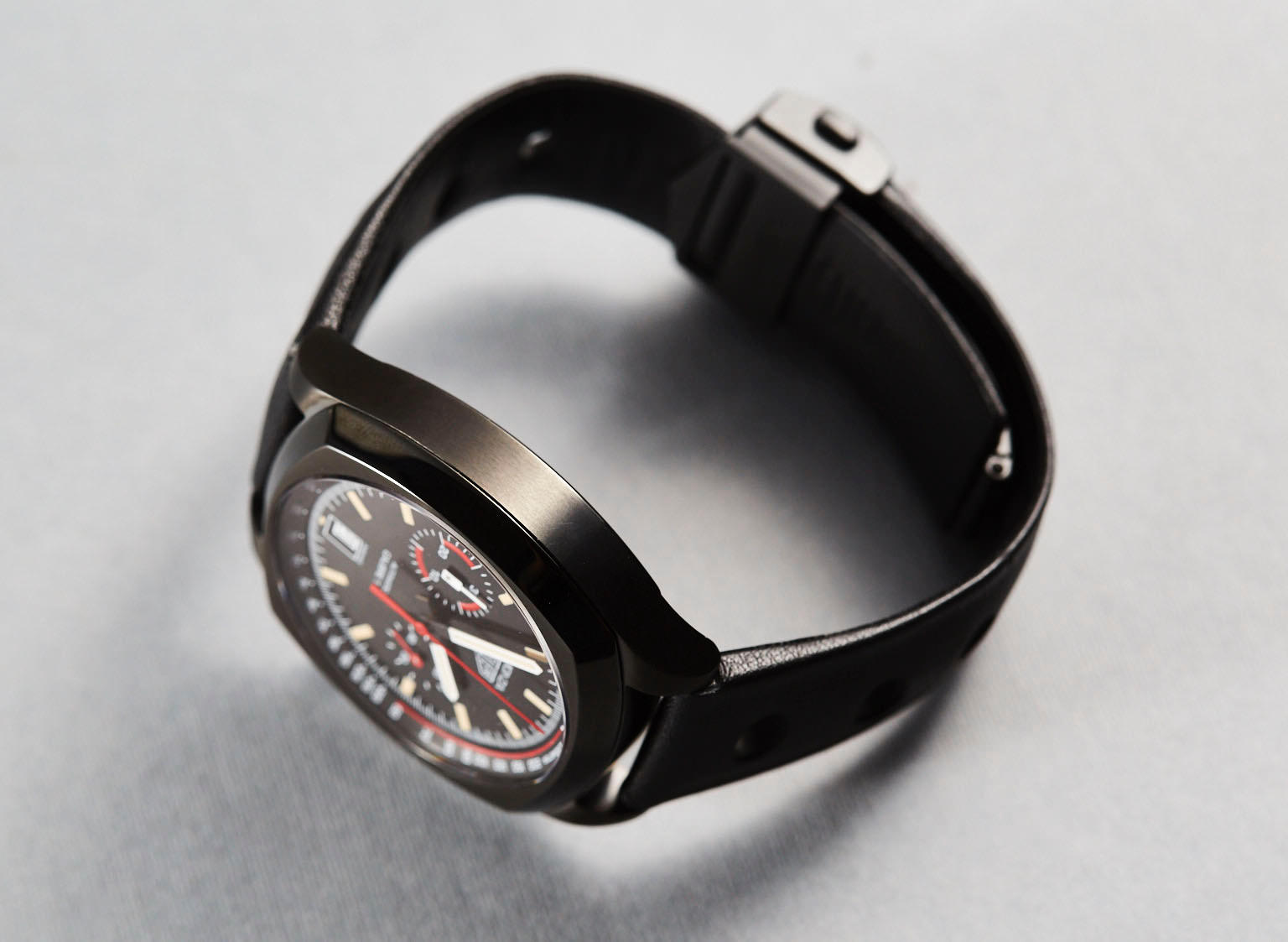
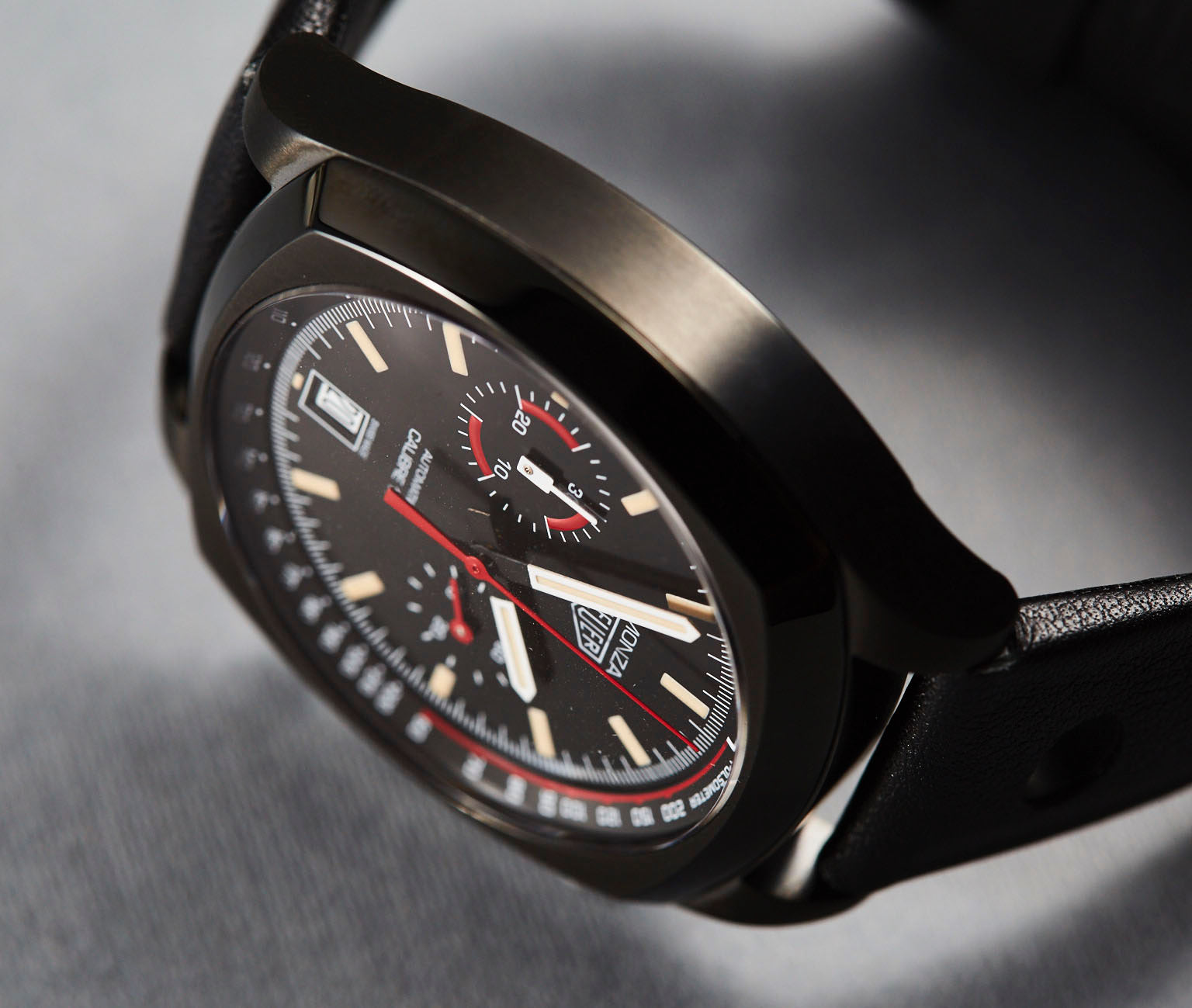 Another unusual feature of the original Monza that is carried forward to 2016 is the use of polished steel chronograph pushers and crown- neither coated in titanium-carbide. The crown features the Heuer logo (there are no TAG Heuer logos on the watch), while the pusher design is lifted straight from the 2000 Monza.
Another unusual feature of the original Monza that is carried forward to 2016 is the use of polished steel chronograph pushers and crown- neither coated in titanium-carbide. The crown features the Heuer logo (there are no TAG Heuer logos on the watch), while the pusher design is lifted straight from the 2000 Monza.
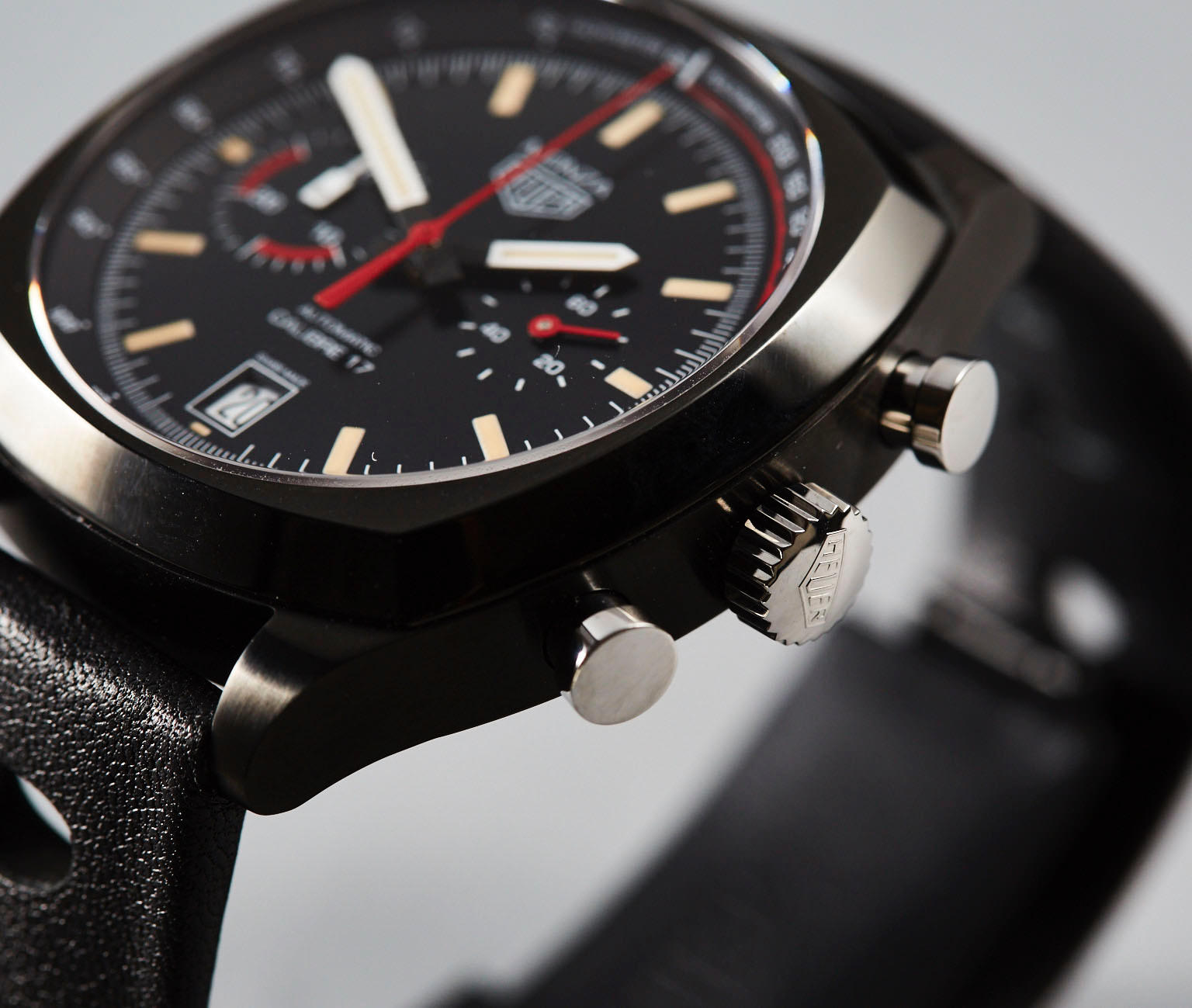

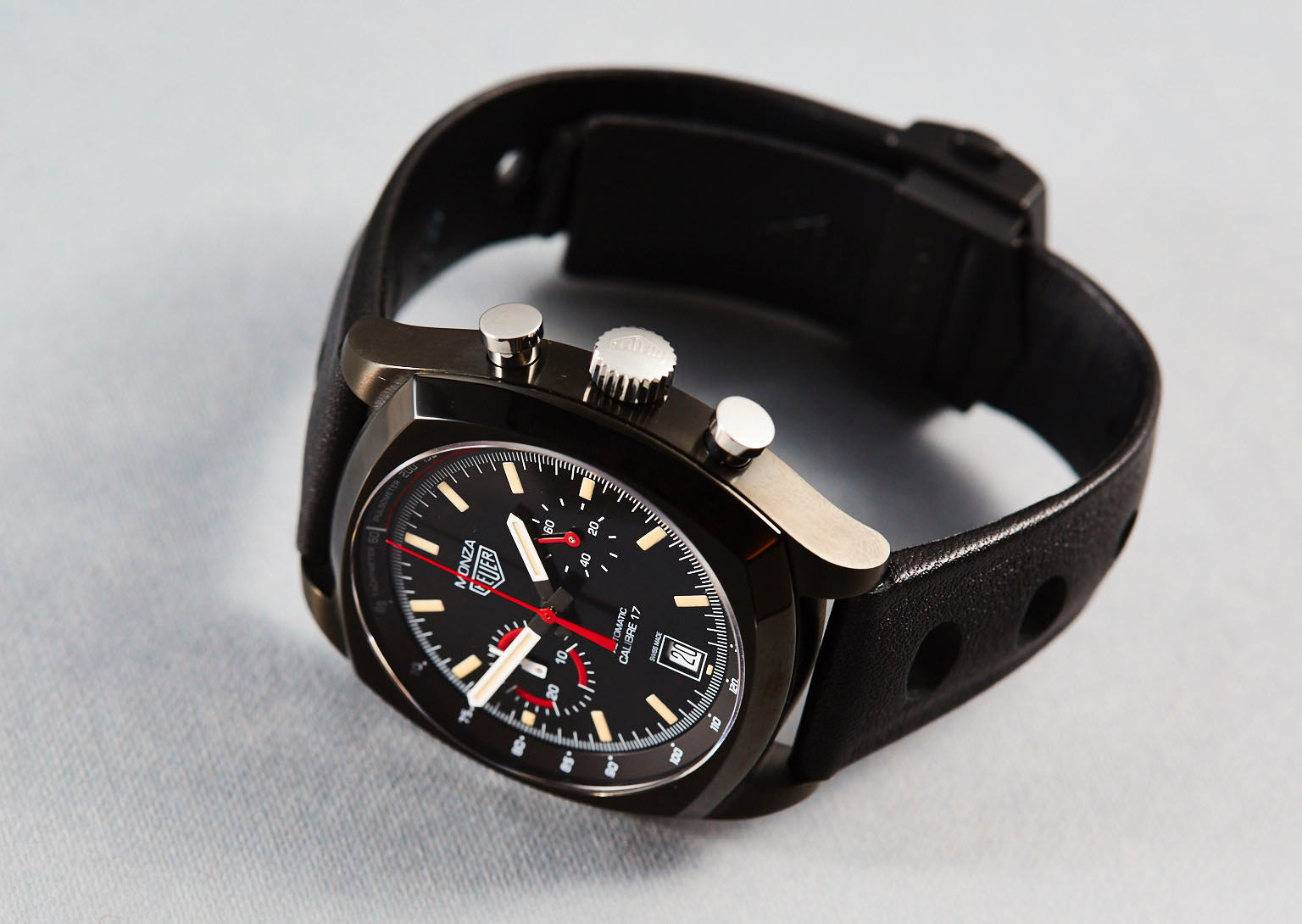 The watch features a sapphire crystal, with anti-reflective coating on both sides and has a slight domed shape, although it’s not that obvious when wearing the watch.
The watch features a sapphire crystal, with anti-reflective coating on both sides and has a slight domed shape, although it’s not that obvious when wearing the watch.
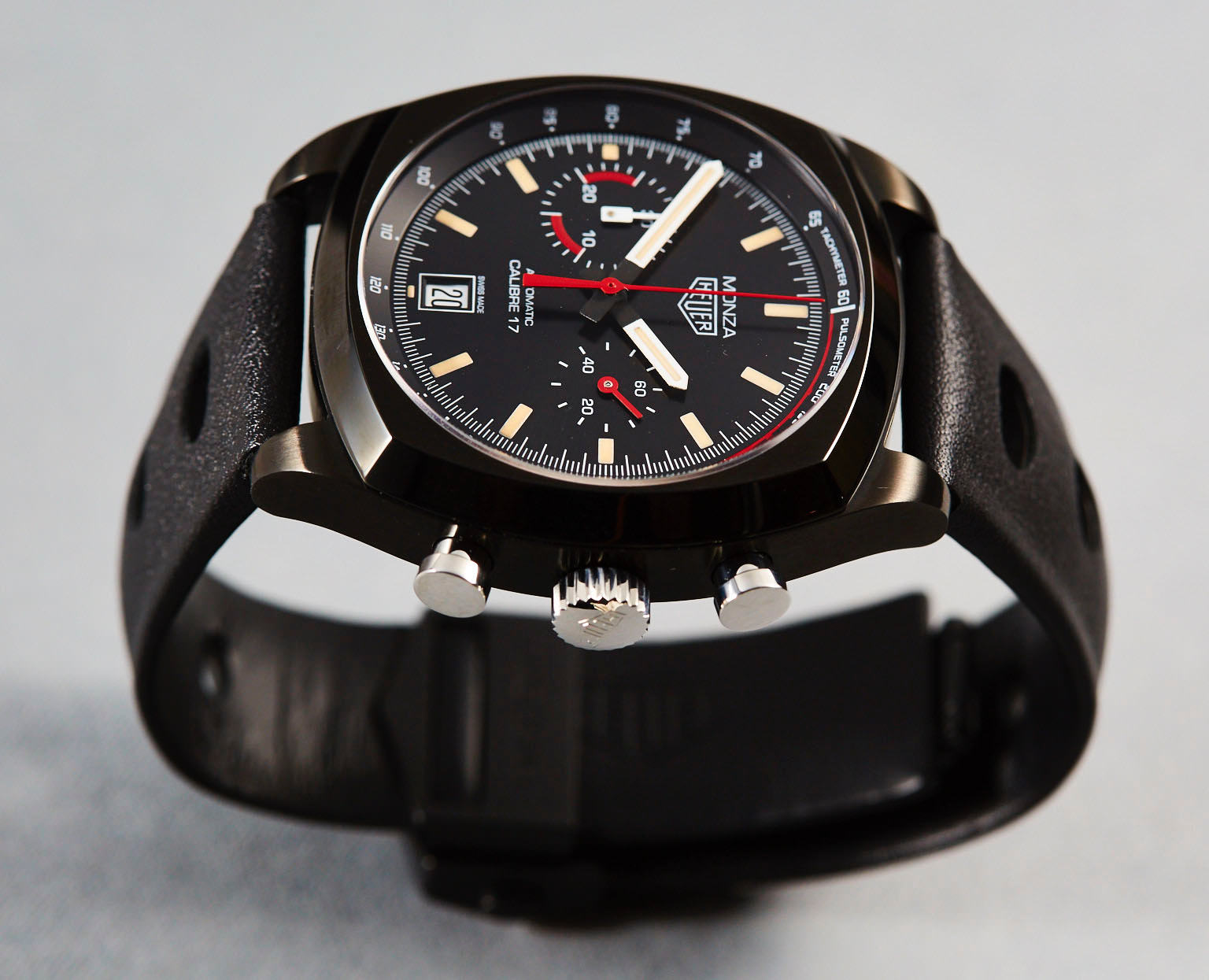
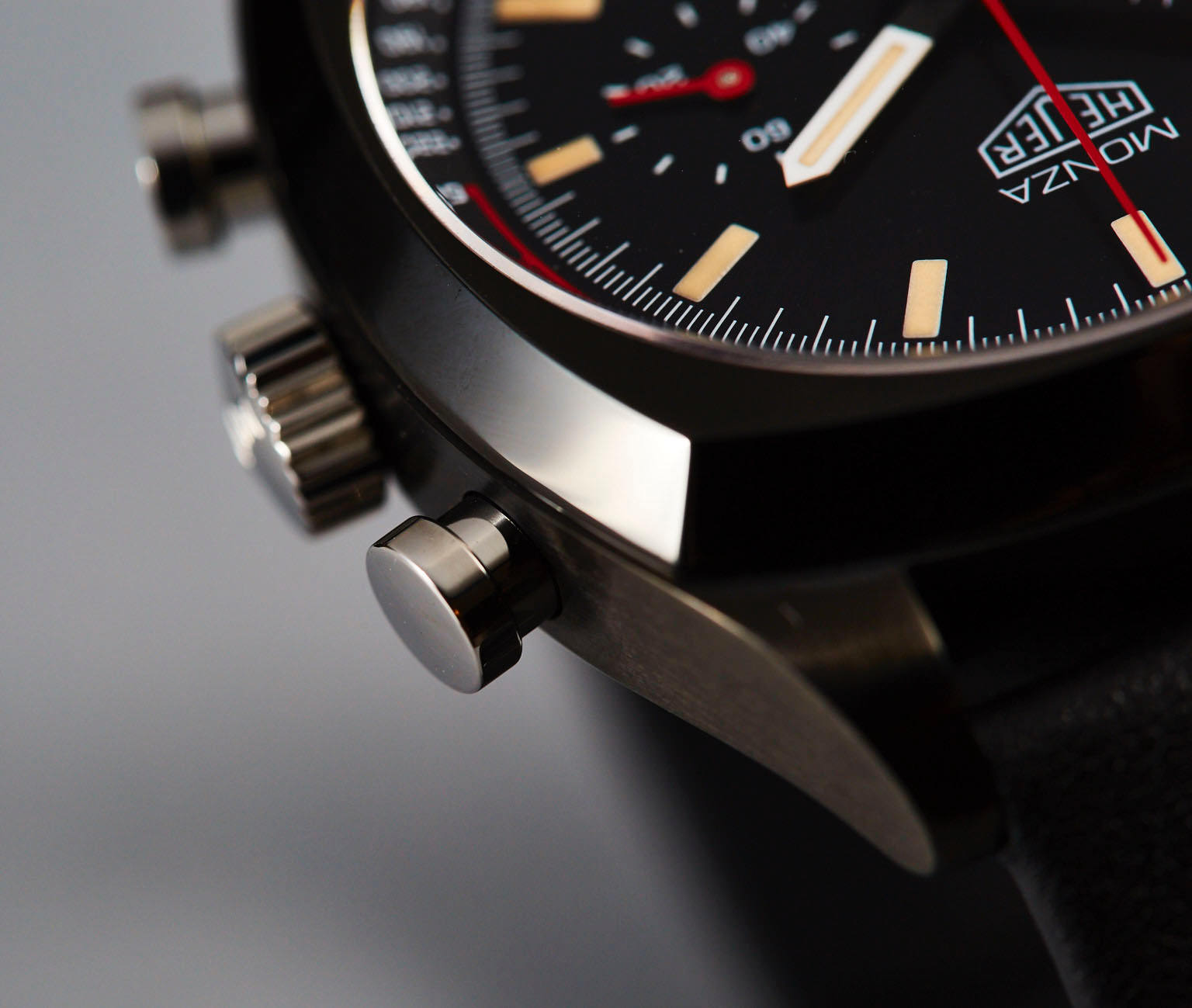
Strap
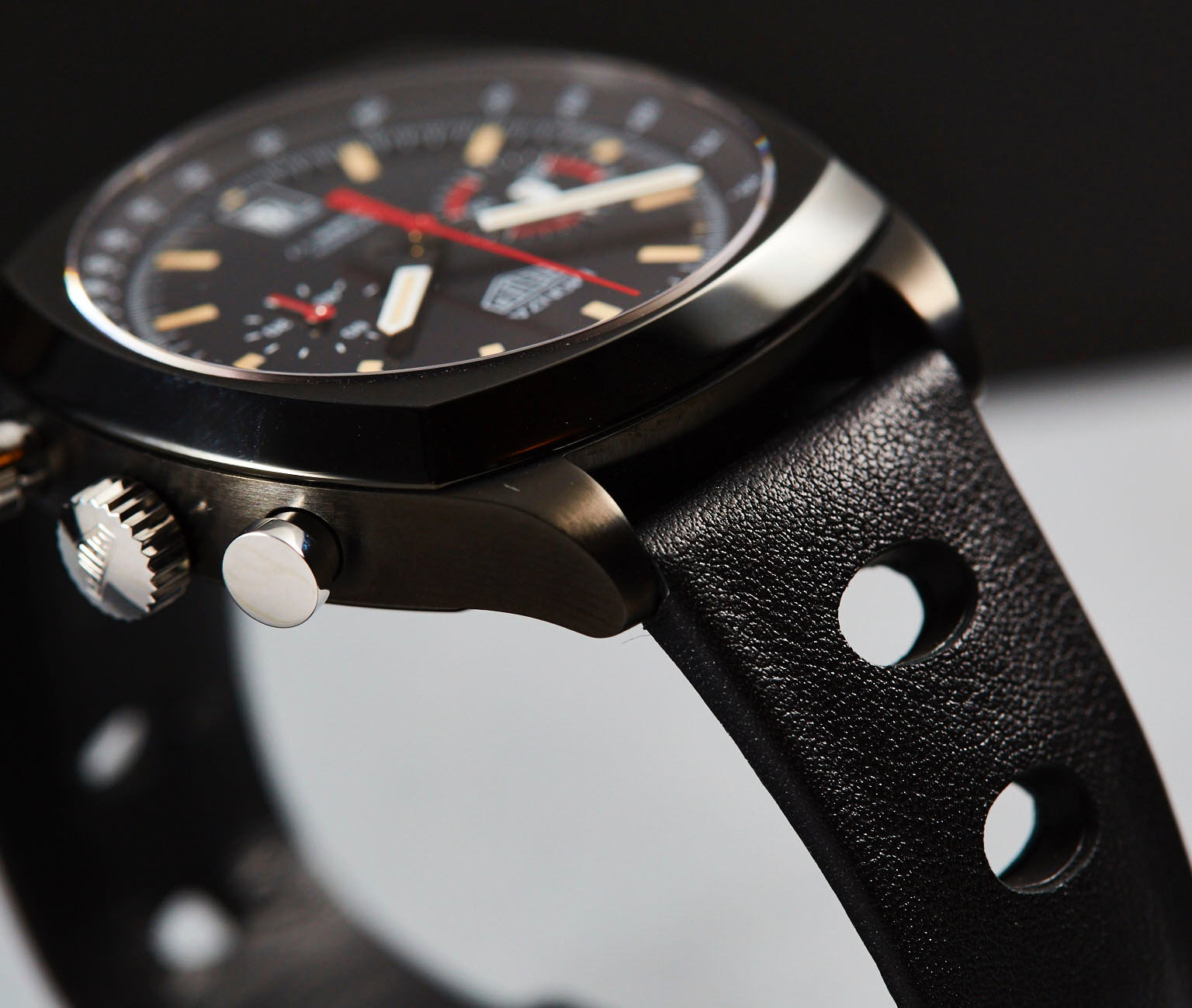 The strap is without doubt one of the best aspects of the watch and one that shows the length that TAG Heuer has gone to ensure authenticity. TAG Heuer could have simply fitted a standard calf-skin strap from the existing Carrera collection, but instead chose to design a “full grain” calfskin leather strap that looks identical to the iconic “Tropic” strap used by the Monza in the 1970s. But while that strap was made from rubber and designed to look like leather, we now have a leather strap designed to look like the old rubber design!
The strap is without doubt one of the best aspects of the watch and one that shows the length that TAG Heuer has gone to ensure authenticity. TAG Heuer could have simply fitted a standard calf-skin strap from the existing Carrera collection, but instead chose to design a “full grain” calfskin leather strap that looks identical to the iconic “Tropic” strap used by the Monza in the 1970s. But while that strap was made from rubber and designed to look like leather, we now have a leather strap designed to look like the old rubber design!
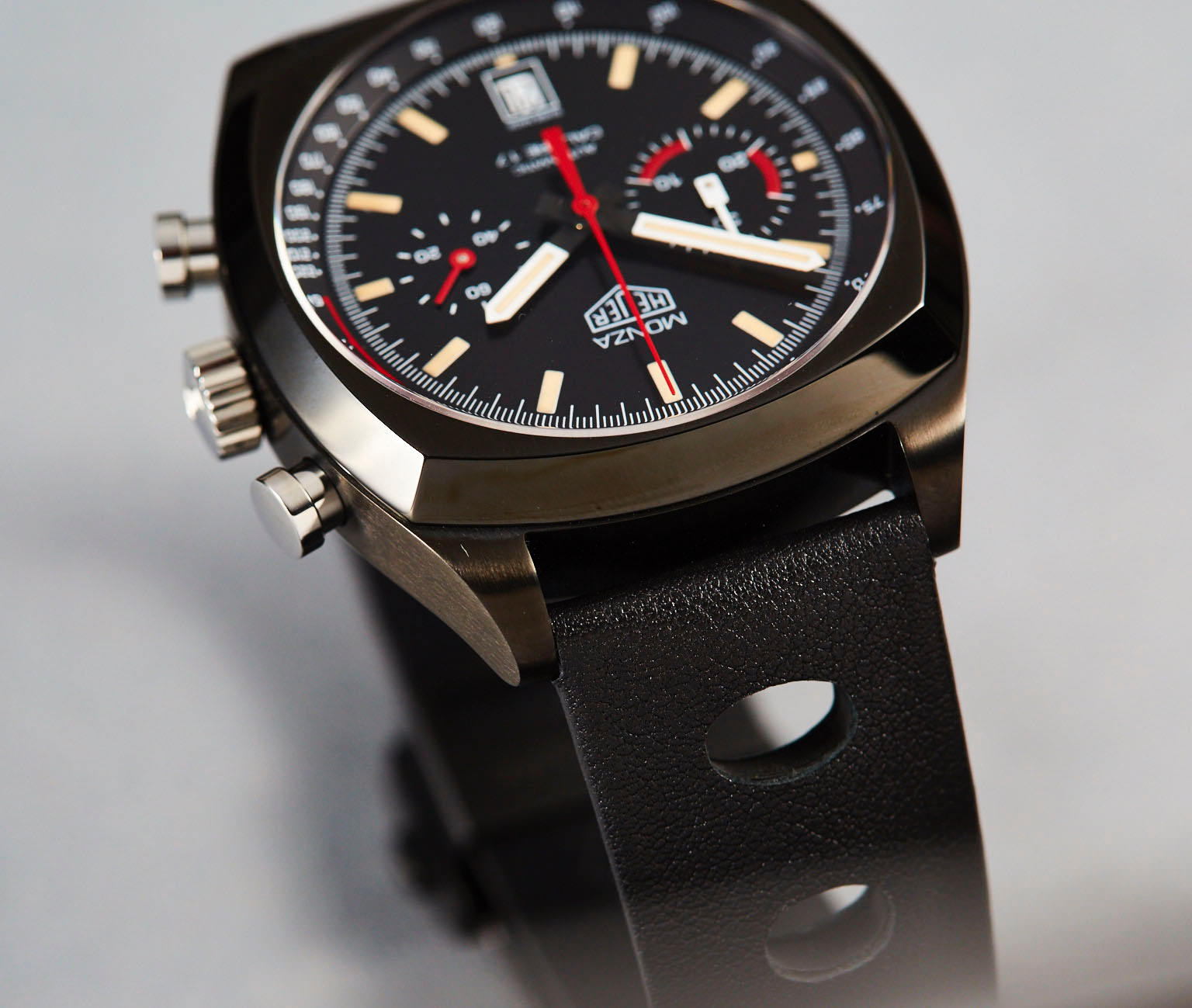 This is one of the nicest leather straps on the market, offering that true 1970s look, but with modern, luxury materials. The clasp is a deployant strap with a titanium folding buckle.
This is one of the nicest leather straps on the market, offering that true 1970s look, but with modern, luxury materials. The clasp is a deployant strap with a titanium folding buckle.
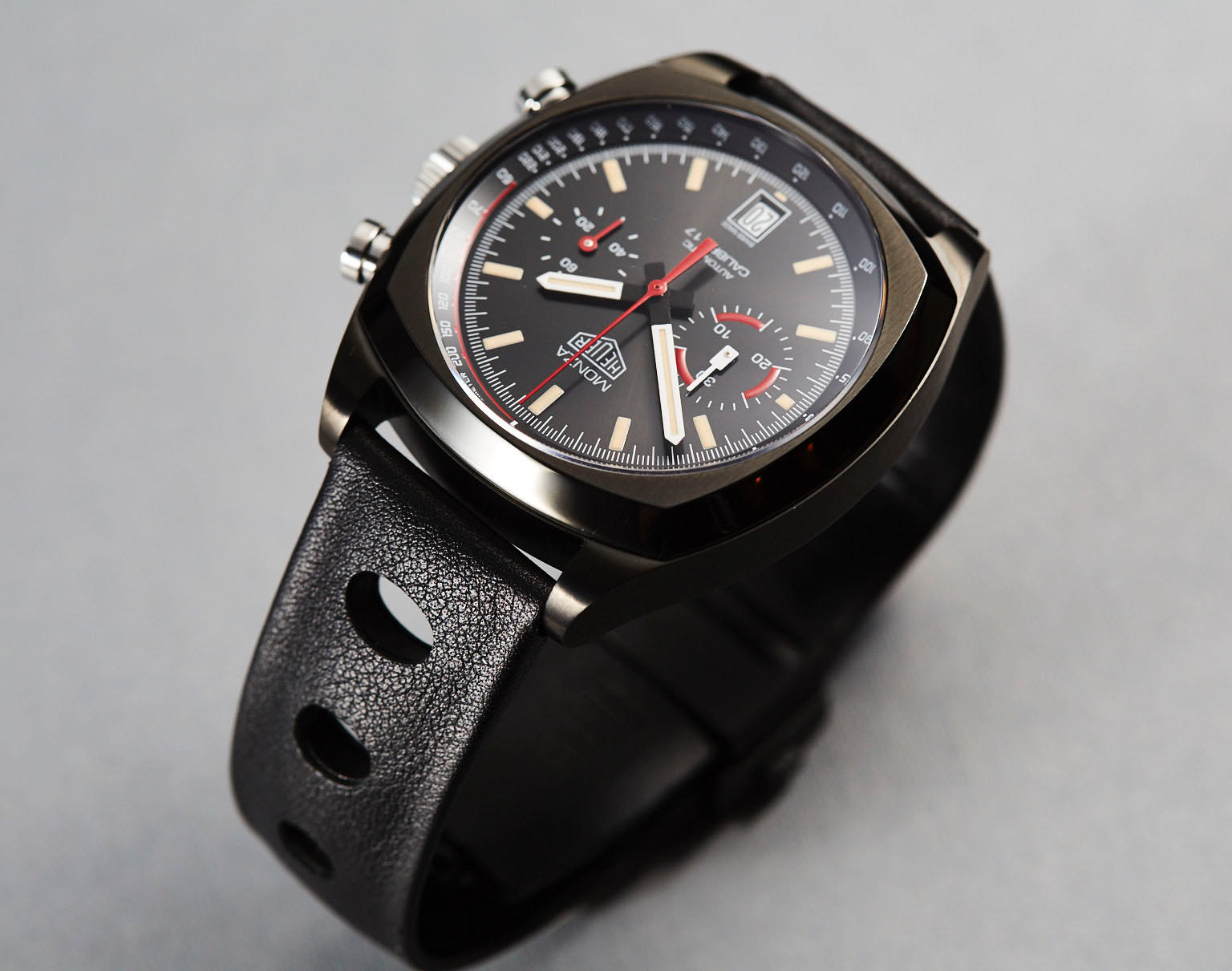
Caseback and Movement
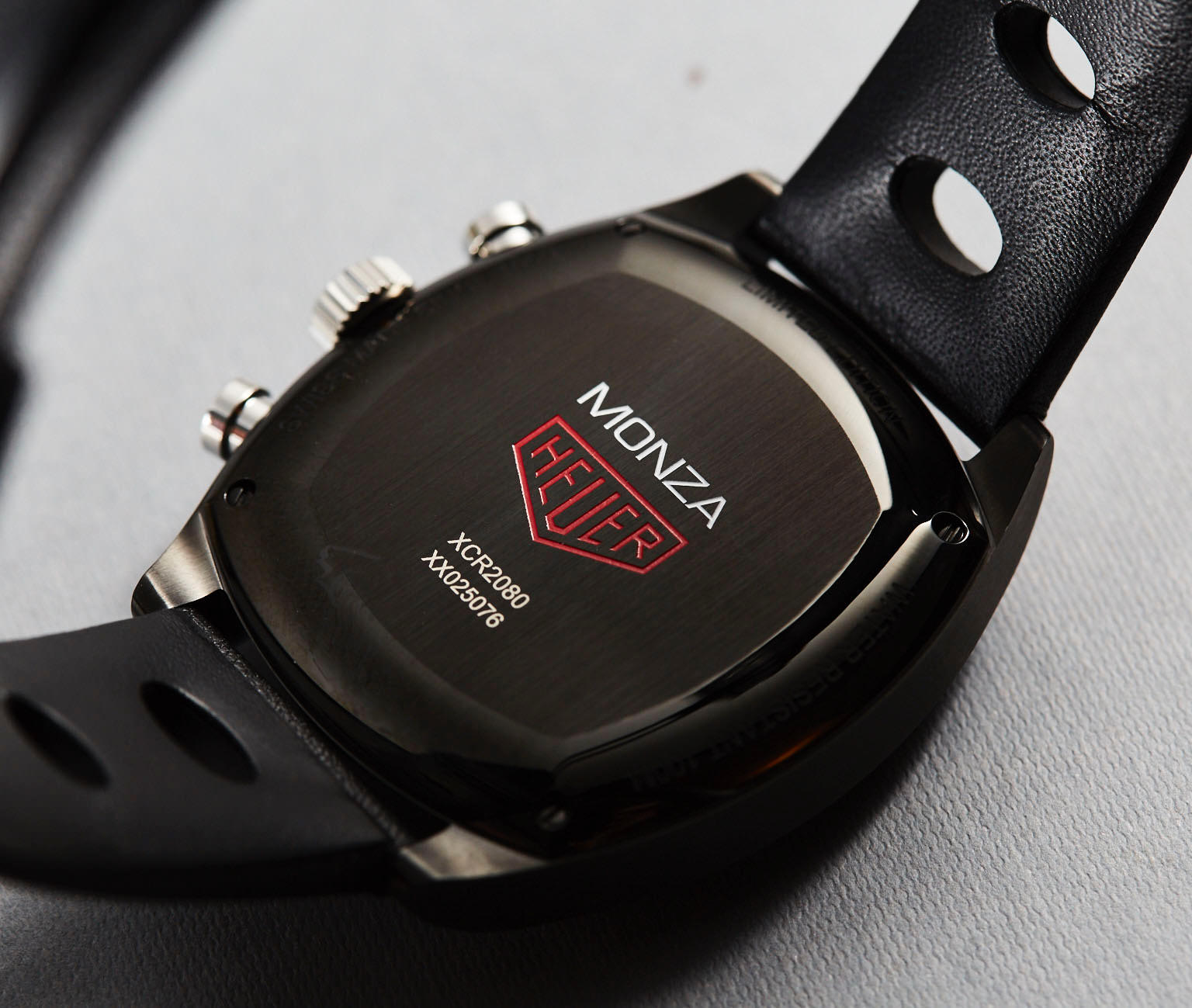 The caseback does not offer a sapphire back (the 2000-era Calibre 36 Monza did), but that’s a small price to pay, because the 2016 model features this ultra-cool bright red Heuer shield with bright-white “Monza” text. Again you see the attention to detail here, with a brushed case back in the centre, edged by a polished finish. We always love when watch companies spend so much time on small details like these that will only ever be seen by the wearer.
The caseback does not offer a sapphire back (the 2000-era Calibre 36 Monza did), but that’s a small price to pay, because the 2016 model features this ultra-cool bright red Heuer shield with bright-white “Monza” text. Again you see the attention to detail here, with a brushed case back in the centre, edged by a polished finish. We always love when watch companies spend so much time on small details like these that will only ever be seen by the wearer.
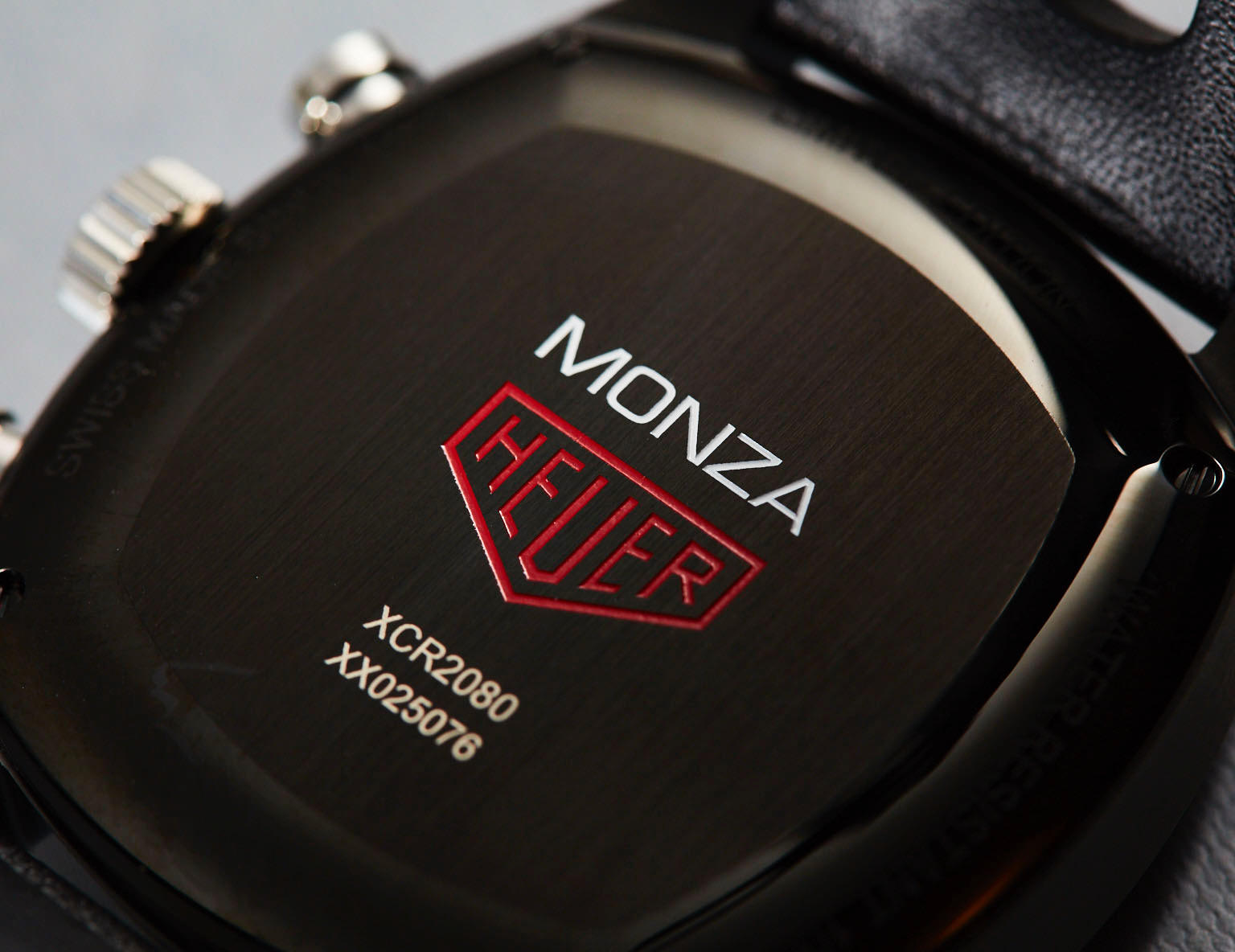 The Calibre 17 movement is the same as the one used in the 2000 TAG Heuer Monza, the Calibre 17 Chronograph, which is an ETA 2894-2 movement, fitted with a TAG Heuer rotor. This is TAG Heuer’s “go-to” movement for two-register Chronograph layouts and is a reliable and well-sorted movement.
The Calibre 17 movement is the same as the one used in the 2000 TAG Heuer Monza, the Calibre 17 Chronograph, which is an ETA 2894-2 movement, fitted with a TAG Heuer rotor. This is TAG Heuer’s “go-to” movement for two-register Chronograph layouts and is a reliable and well-sorted movement.
On the Wrist
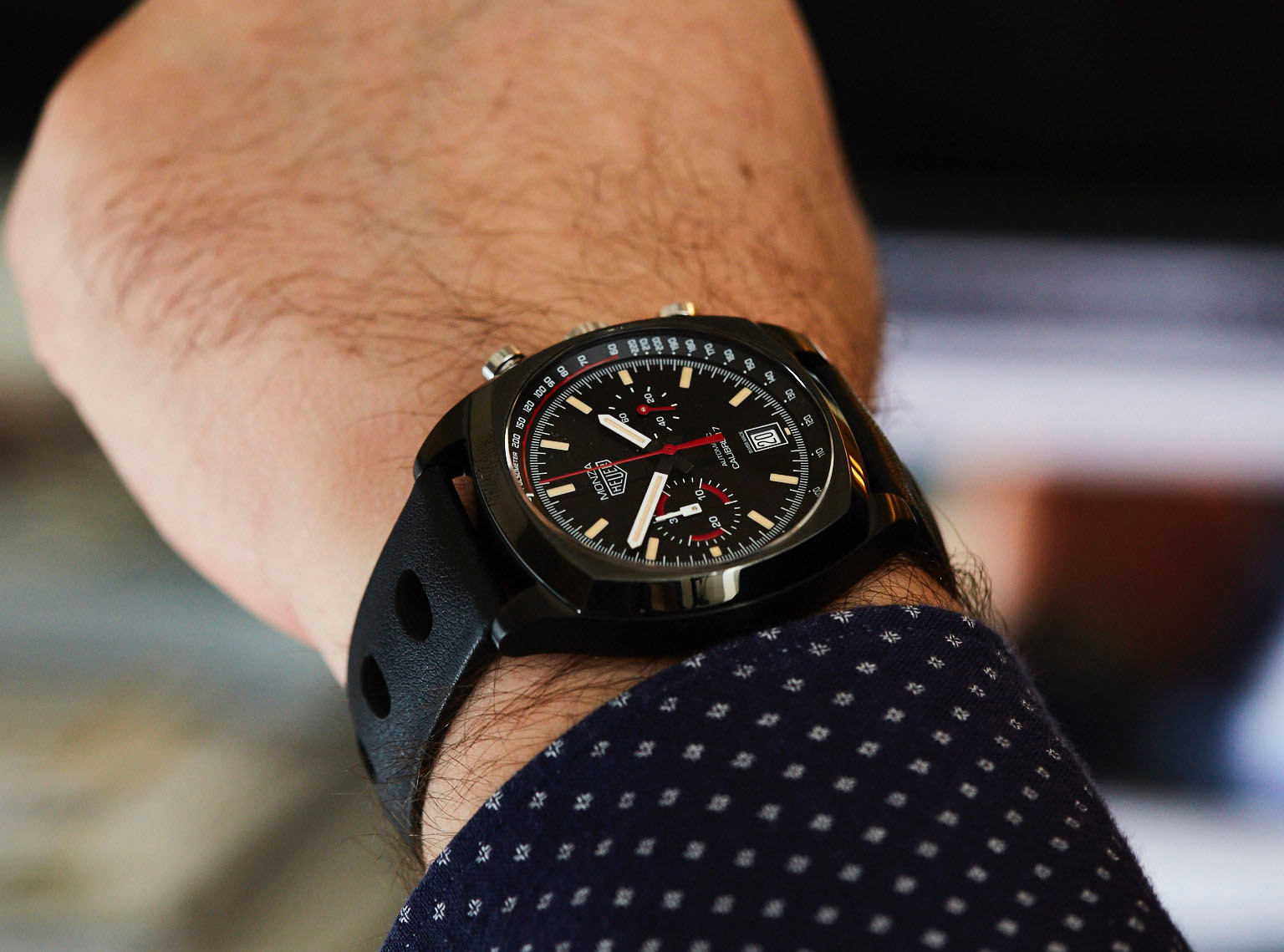 Confession time: we loved the look of the new Monza when we first saw the photo, but there was one concern- the decision to increase the size of the case from the original 38mm to a larger 42mm- remember that it’s usual to have a smaller diameter on a square-cased watch (for example, the Monaco is “only” 39mm). To us, the 38mm 2000 Monza is perfect…which means the 2016 must be too big- or is it?
Confession time: we loved the look of the new Monza when we first saw the photo, but there was one concern- the decision to increase the size of the case from the original 38mm to a larger 42mm- remember that it’s usual to have a smaller diameter on a square-cased watch (for example, the Monaco is “only” 39mm). To us, the 38mm 2000 Monza is perfect…which means the 2016 must be too big- or is it?
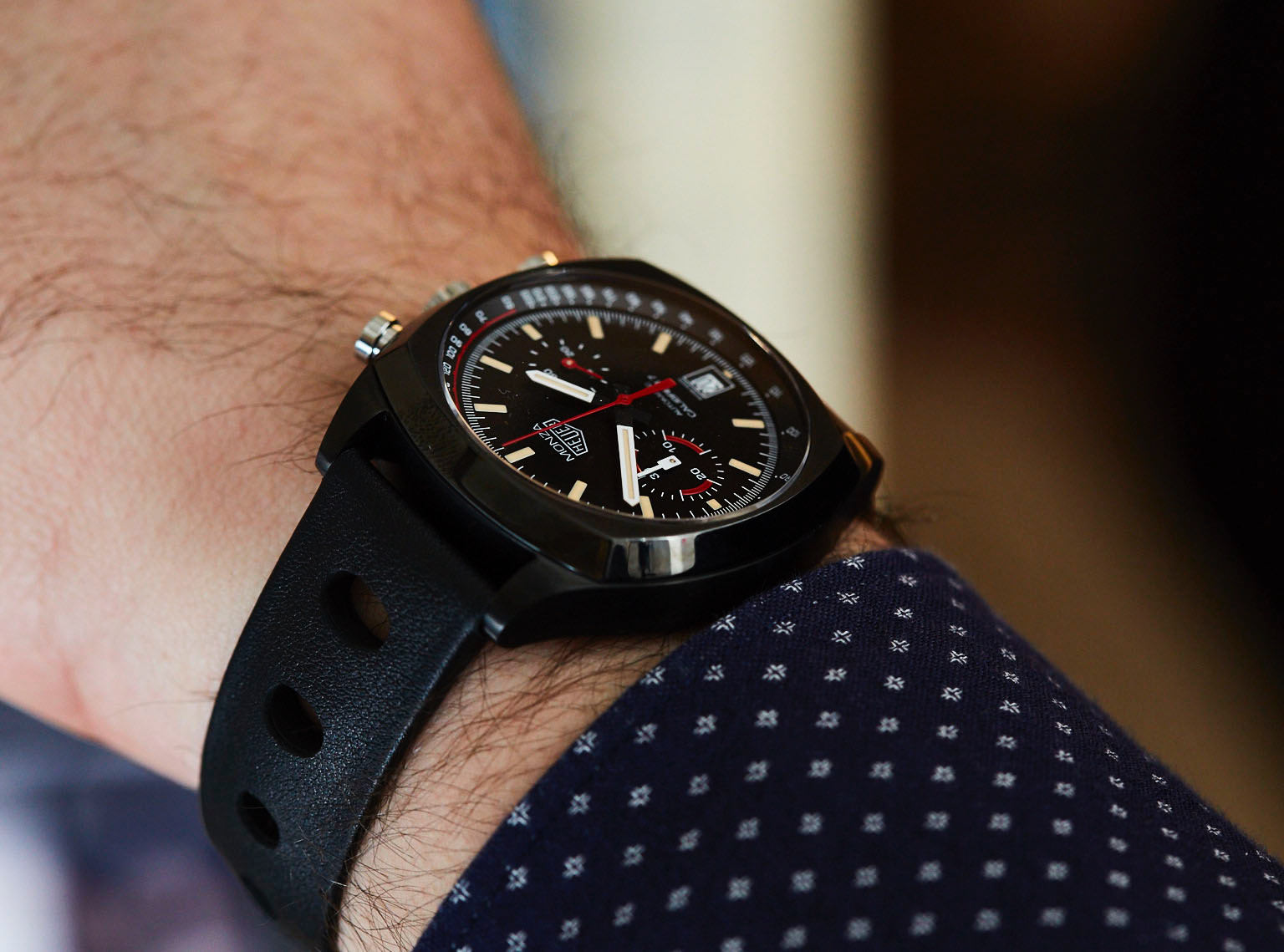 The saving grace of the increased size is that firstly, it fits with the sporty-nature of the watch and secondly, the watch maintains a relatively slim case height. The 2000 Monza was more of a dressy chronograph, a style that is better suited to a smaller case. Helping the size equation is also the use of a light-weight titanium case
The saving grace of the increased size is that firstly, it fits with the sporty-nature of the watch and secondly, the watch maintains a relatively slim case height. The 2000 Monza was more of a dressy chronograph, a style that is better suited to a smaller case. Helping the size equation is also the use of a light-weight titanium case
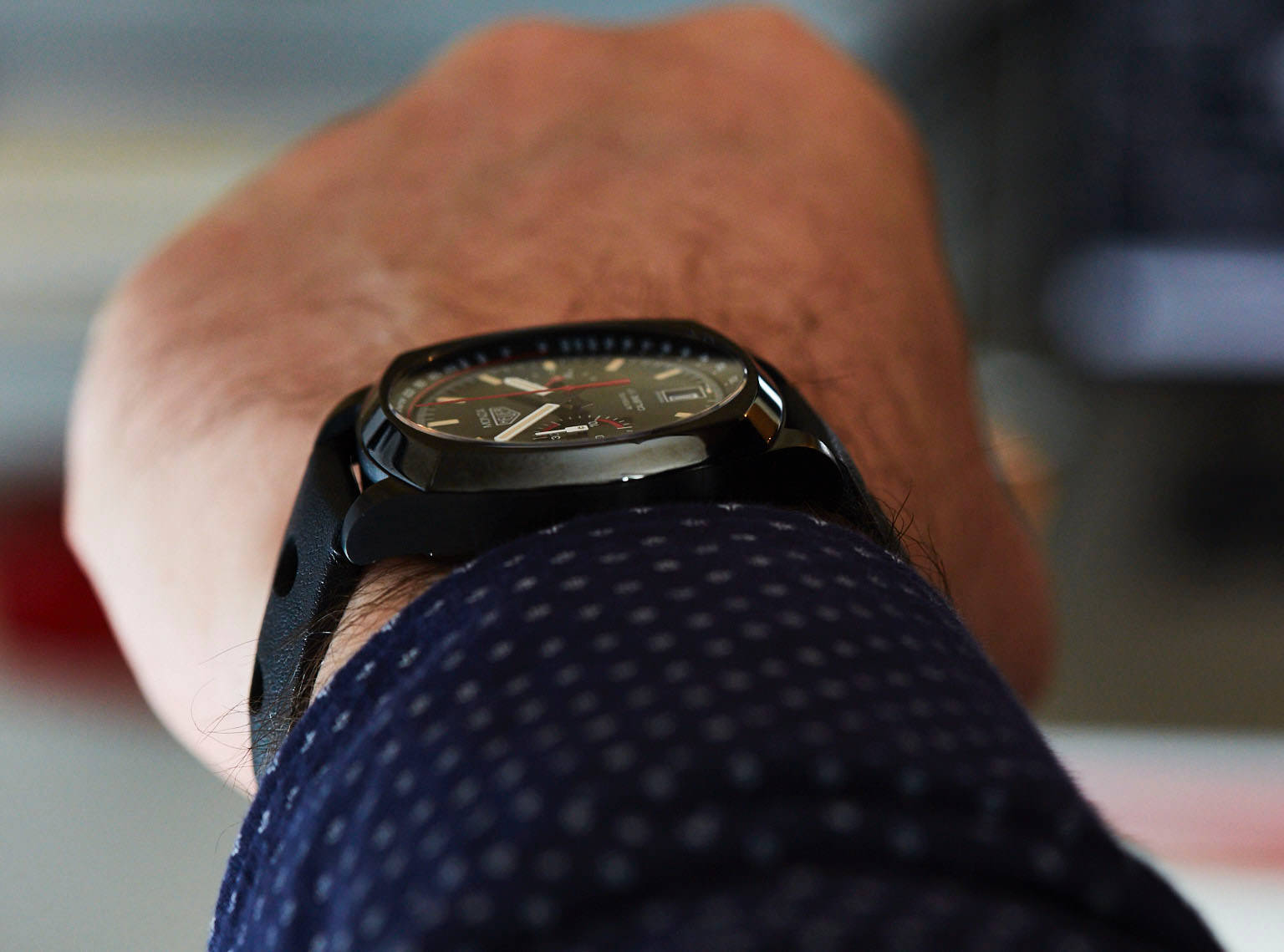 So, let’s go back to the original question- is the new Monza too big? Well, it’s not too big, but we probably would have left the case size where it was- having said that, case size is always a personal choice. As recent sales figures show, TAG Heuer clearly knows its customers and their preference for larger case sizes, even though we’d rather stay at 41mm and below for the majority of watches.
So, let’s go back to the original question- is the new Monza too big? Well, it’s not too big, but we probably would have left the case size where it was- having said that, case size is always a personal choice. As recent sales figures show, TAG Heuer clearly knows its customers and their preference for larger case sizes, even though we’d rather stay at 41mm and below for the majority of watches.
Putting dimensions to one side, the Monza looks fantastic on the wrist- we love it. The deployant offers infinite size adjustment, meaning it’s easy to find the right fit for your wrist.
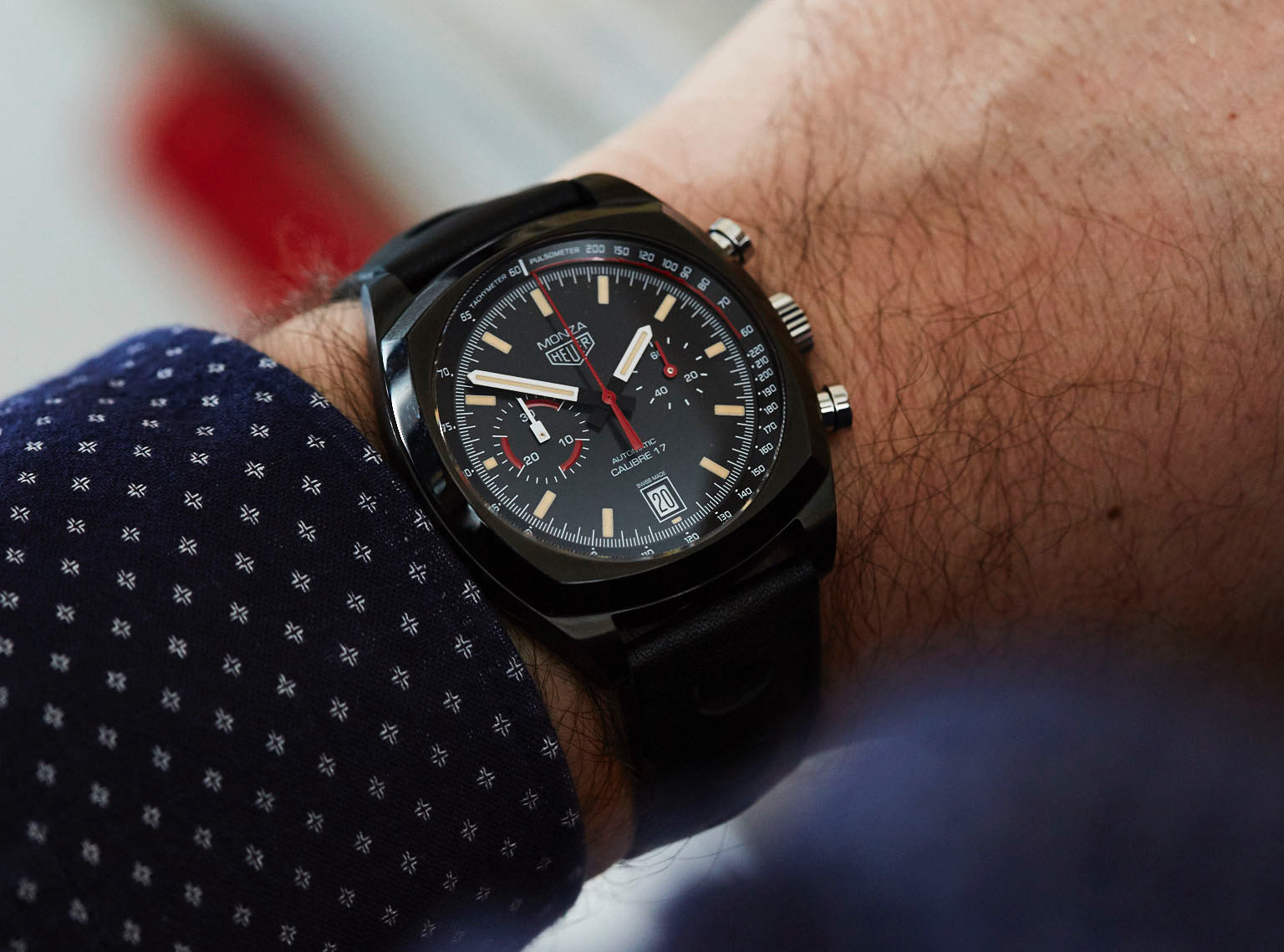
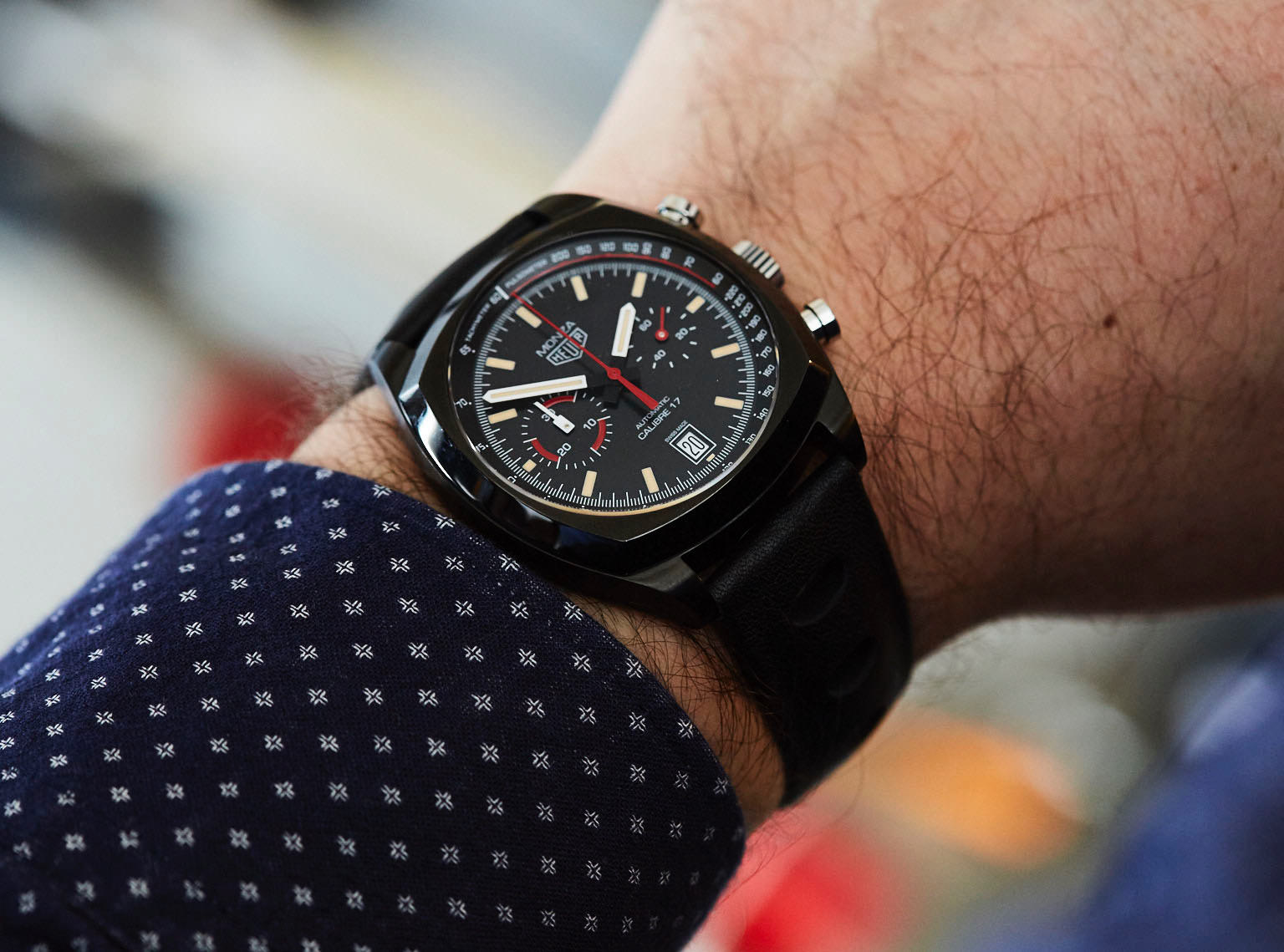
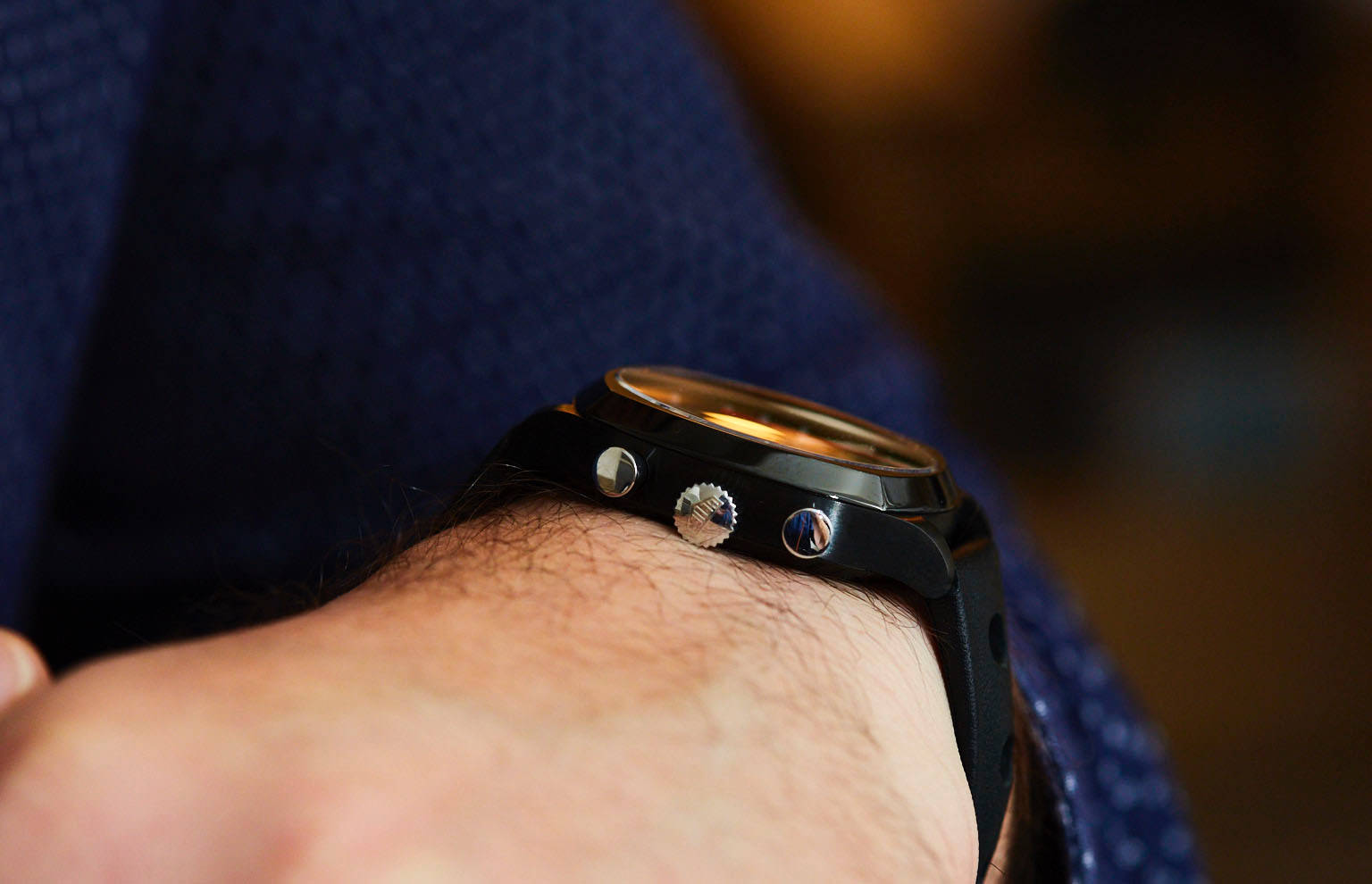
Price and Availability- Heuer Monza CR2080
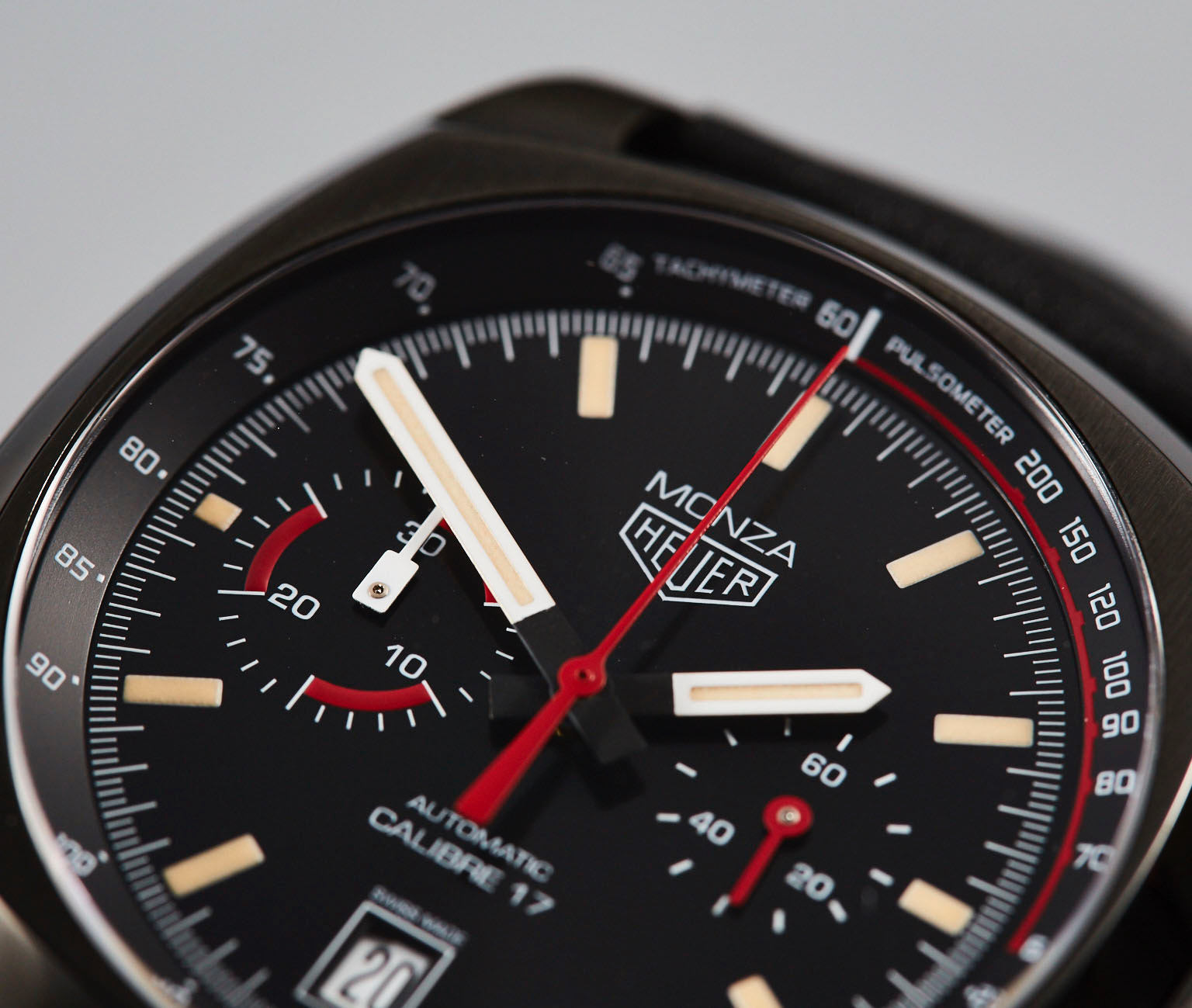 Prices for the 2016 TAG Heuer Monza 40th Edition are as follows:
Prices for the 2016 TAG Heuer Monza 40th Edition are as follows:
- Switzerland- CHF4,900
- Europe- €4,700
- North America- US$5,200
- Hong Kong- HKD40,900
The watch is a numbered limited edition, although at the time of going to “print”, TAG Heuer was yet to confirm how many Monza’s would be made. We’ll update the article when numbers are confirmed.
In Summary
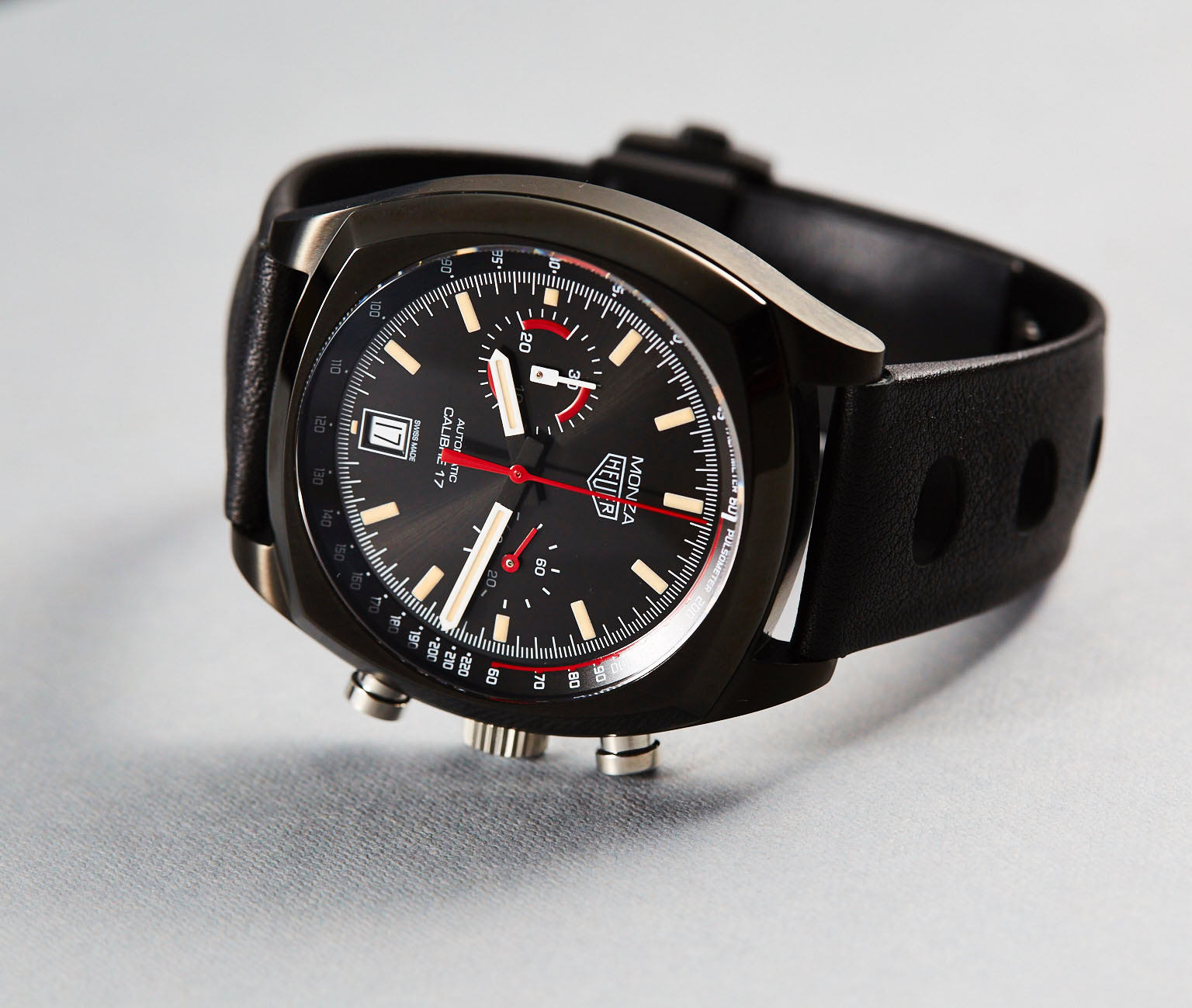 The 2000 Monza is one of our favorite TAG Heuer designs, and the decision to pair that wonderful cushion case with the sporty dial of the 1970s is a combination that shouldn’t work, but certainly does. The hype around this watch is justified, with a look and feel unlike any other watch on the market today- no-one will mistake your new Monza for anything else.
The 2000 Monza is one of our favorite TAG Heuer designs, and the decision to pair that wonderful cushion case with the sporty dial of the 1970s is a combination that shouldn’t work, but certainly does. The hype around this watch is justified, with a look and feel unlike any other watch on the market today- no-one will mistake your new Monza for anything else.
TAG Heuer has gone to extreme lengths to maintain the authenticity of the original 1976 Monza, from the design and font on the dial, to the use of stainless steel pushers and crown, and to the beautiful grain calfskin strap. Detail, detail, details.
There is enough here for vintage lovers as well as for those who never knew the original models- the Monza has the making of a true modern classic.
We like:
- The design is a perfect combination of two-generations of the Monza, yet the combination is harmonious and offers the best of both designs
- TAG Heuer has a history of offering sporty models in Red and Black- the Monza perfectly combines these colours for a sharp, distinctive look
- The case design is beautiful, especially the edged design on the upper case
We’d change:
- Use of standard lume, rather than the aged look
- The original was 38mm, the new one is 42mm- we’d meet in the middle at 40mm for the best of both worlds
- We get the use of the Calibre 17, but would be great to see a modified CH-80 on special editions like this
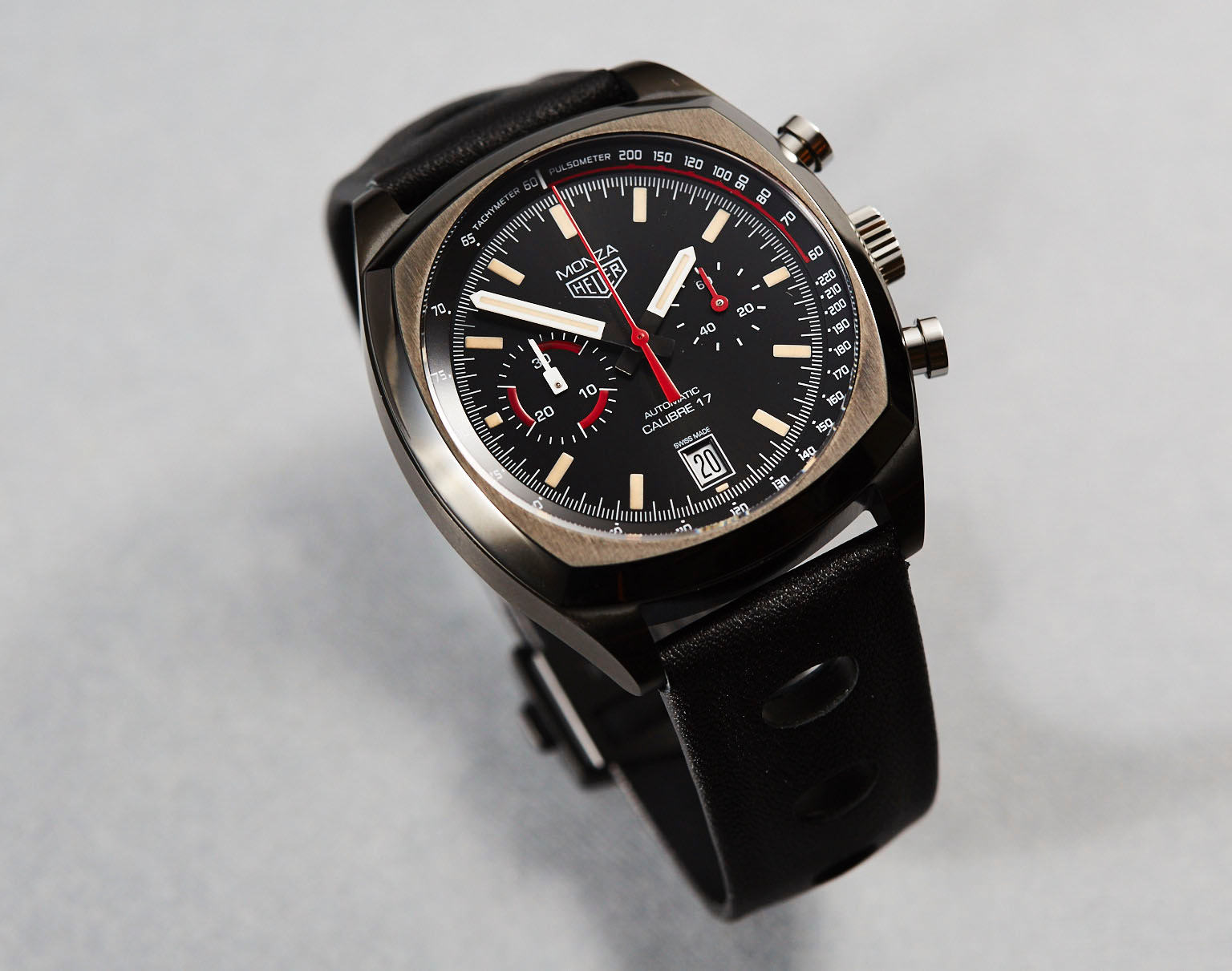
***
Join the Discussion

